Caterpillars come in all colors and color combinations. Orange and black color combinations are common as they signal a species that’s potentially poisonous to predators.
Orange sections can come in the shape of marks or dots. Even black marks or dots can be seen across caterpillars.
Moths and butterflies in North America often have black and orange coloring which they may carry into adulthood.
Table of Contents
Are Orange and Black Caterpillars Poisonous?
Most orange and black caterpillars aren’t poisonous. While handling them is still not advisable without protective gloves, most orange and black caterpillars aren’t harmful to humans.
Even poisonous species cause skin-level reactions only when it comes to their interactions with humans.
Some species have toxin glands connected to hollow hairs. These are the caterpillars most likely to cause skin irritation, severe rashes, and even skin swelling.
Some orange and black caterpillars are more dangerous to animals than humans.
Much of the damage these caterpillars cause still affect humans indirectly. They eat through trees, legumes, and flowers.
Some caterpillars can’t be fully controlled with insecticides either, which means crops are most susceptible to their damage.
Types of Orange and Black Caterpillars
The following species are native to North America. They can be found in the US and sometimes in Canada.
1. Pipevine Swallowtail Caterpillar
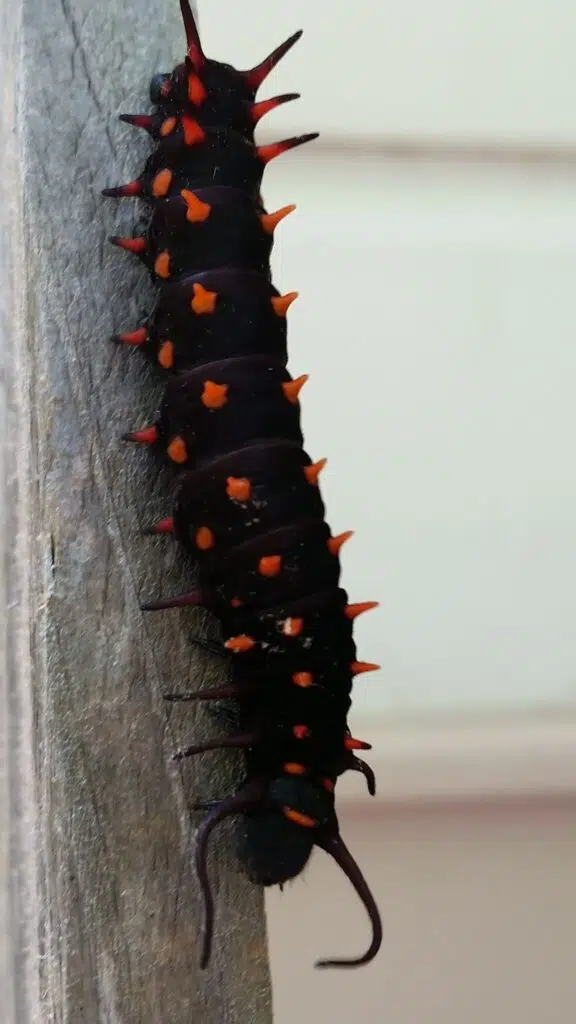
Pipevine Swallowtail caterpillars (Battus philenor) have orange tubercles. These tubercles have varying colors depending on where the caterpillar lives.
Populations across the Eastern United States have orange tubercles while those in Southern states can have red tubercles.
These colorful tubercles are short in the first instar slowly growing into long tubercles and even turning into filaments.
The Pipevine Swallowtail caterpillar is mostly dark brown or brown-red across its instars.
All types of hosts have been noted for the caterpillar of the Pipevine Swallowtail.
Knotweed is a common host plant. Even wild ginger is a common choice for the caterpillar.
2. Red-humped Caterpillar
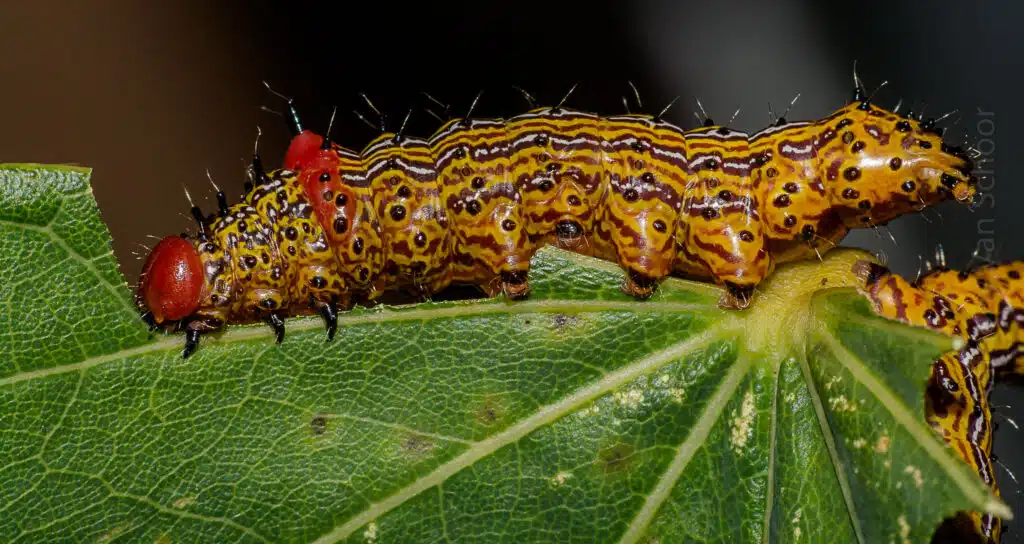
Red-humped caterpillars (Oedemasia concinna) change colors through instars.
The eggs of the species are yellow. Orange color is specific to these caterpillars as soon as they hatch. This color tends to darken and turn into a final brown and red color combination in the last instar.
Orange coloring remains a secondary color on the adult caterpillar, mainly represented by vertical stripes across the body.
These caterpillars tend to grow together in their first instars.
Damages they make to leaves are also considerable. The host plants and trees these caterpillars feed on may only be protected by heavy insecticide use.
3. Oleander Caterpillar
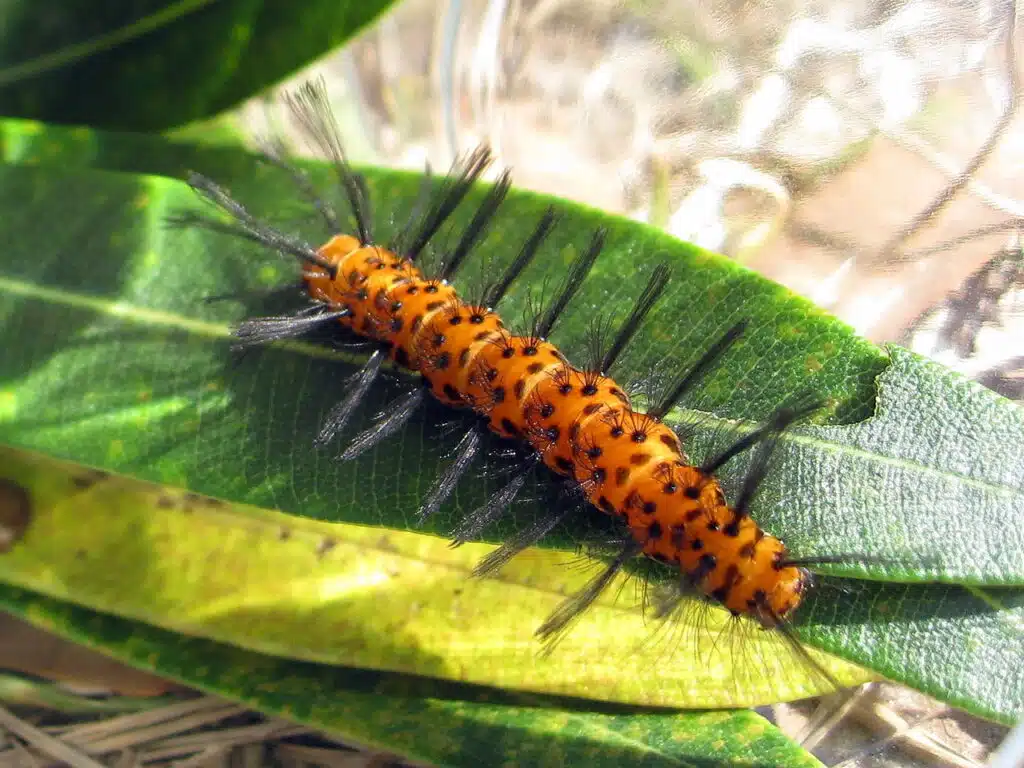
Oleander plants are the common host of the Oleander caterpillar (Syntomeida epilais).
This species grows to a large size and an orange color. Black tufts and black hairs are characteristic of the species, even if they don’t cover the entire body.
These caterpillars are further known for consuming entire leaves of oleander plants.
A long list of predators is tied to this caterpillar, which limits the damage it creates.
This species is only consumed by some birds, due to its bad taste.
Stink bugs and tachinid flies are among the most common predators of the species which may deal with its bad taste.
Oleander plants are cared for manually when these caterpillars are removed leaf by leaf. Insecticide damages the host plants of these caterpillars.
4. Malachite Caterpillar
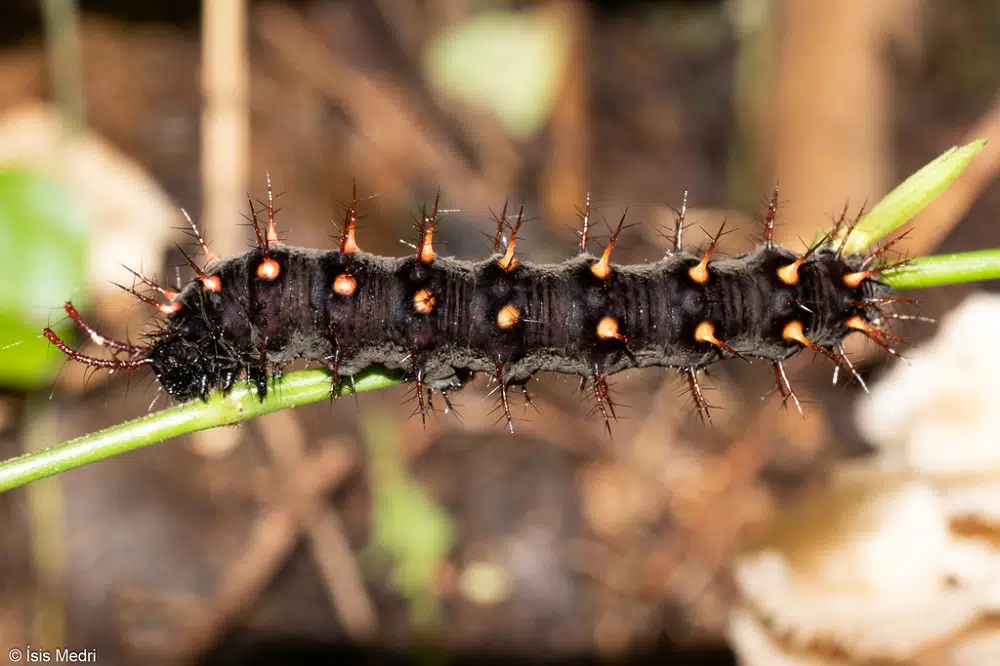
The black color with multiple orange dots across the dorsum is specific to these caterpillars (Siproeta stelenes).
Native to the United State, the species has different orange nuances, depending on its region.
Southern parts of Texas show large Malachite caterpillar populations.
Smaller and more remote populations are also seen in Florida, Arizona, and New Mexico.
Ruellia plants are among the most common hosts of the species. These are colorful plants that provide the leaves for the caterpillars to feed on.
Adults of the species solely feed on rotting fruit.
You can find these caterpillars in areas with citruses such as orchards. Avocado orchards are the most common host for the species.
5. Spiny Elm Caterpillar
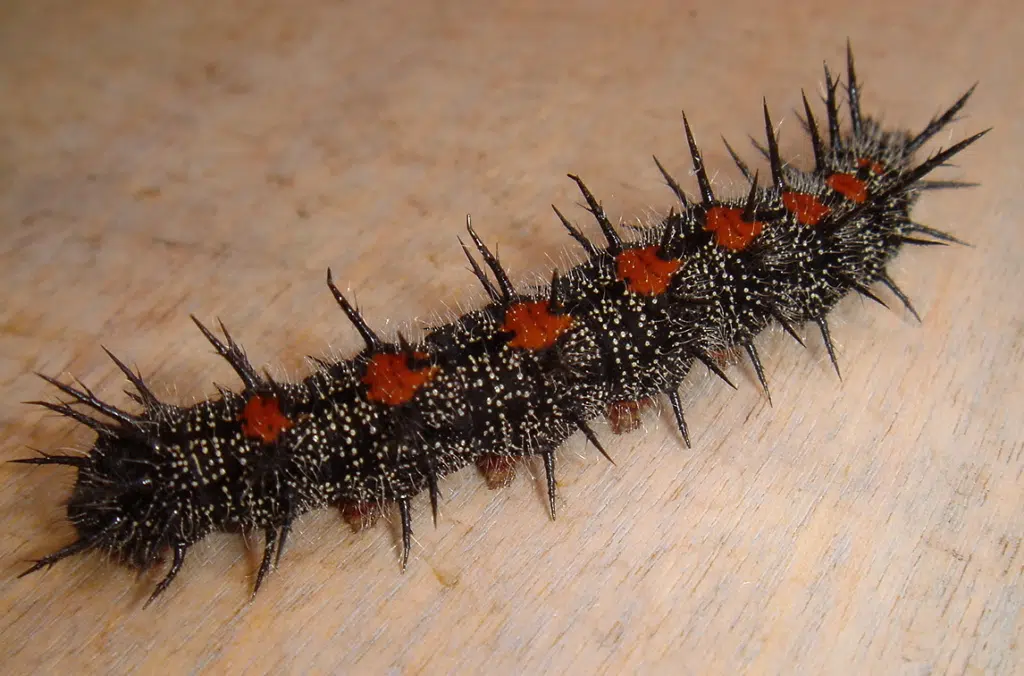
Caterpillars of this genus (Nymphalis antiopa) have a mainly black body with orange marks across the dorsum.
The role of these orange spots is to signal a potentially-poisonous species to predators.
These spots can turn red towards later instars or be red in the case of Spiny Elm caterpillars in some regions.
Common in North America, Spiny Elm caterpillars are seen together as they live in silken nests on host trees.
Willows are the most common hosts.
Elm and hackberry are also common hosts for the growing caterpillars.
Adult Spiny Elm butterflies eat tree sap from the same species as well as rotting fruit.
6. Cinnabar Moth Caterpillar
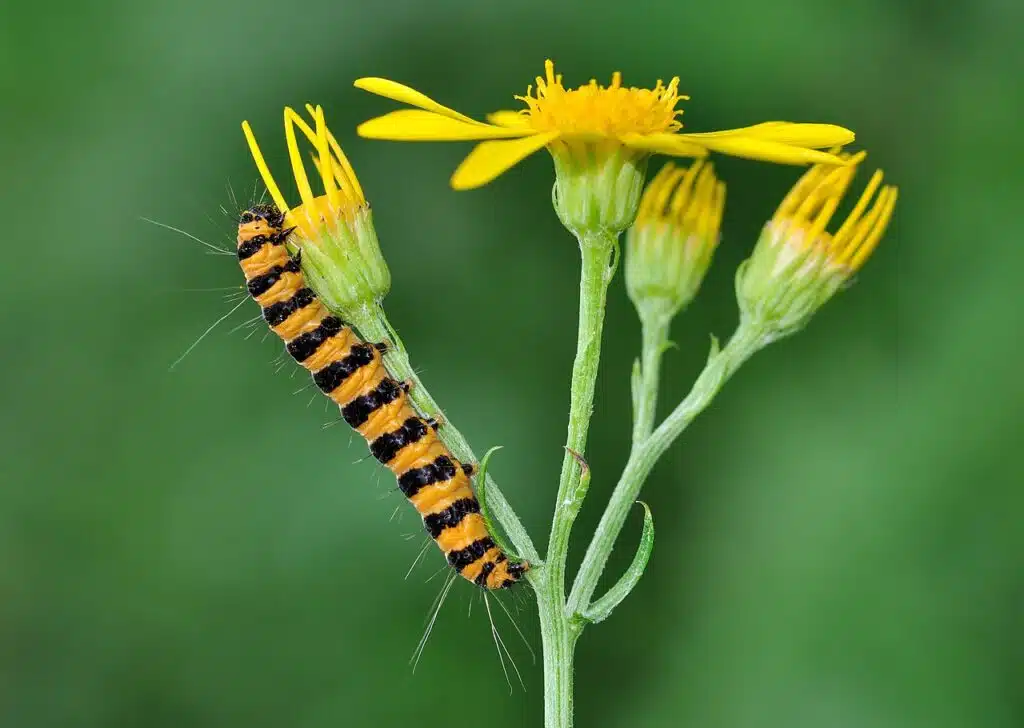
Alternating black and orange bands are seen across the body of the Cinnabar Moth caterpillar (Tyria jacobaeae).
As Spiny Elm caterpillars, Cinnabar Moth caterpillars grow to a length of at least 2 inches.
These are among the few caterpillars considered beneficial to the ecosystem. The species controls ragwort across crops and gardens.
Native to the Western United States, the species is introduced in areas with a risk of overgrowing ragwort.
These caterpillars are also cannibalistic.
Caterpillars eating each other are common in the Spiny Elm species whenever food sources are scarce.
Ants are some of the most common Cinnabar Moth caterpillar predators.
7. Isabella Tiger Moth Caterpillar
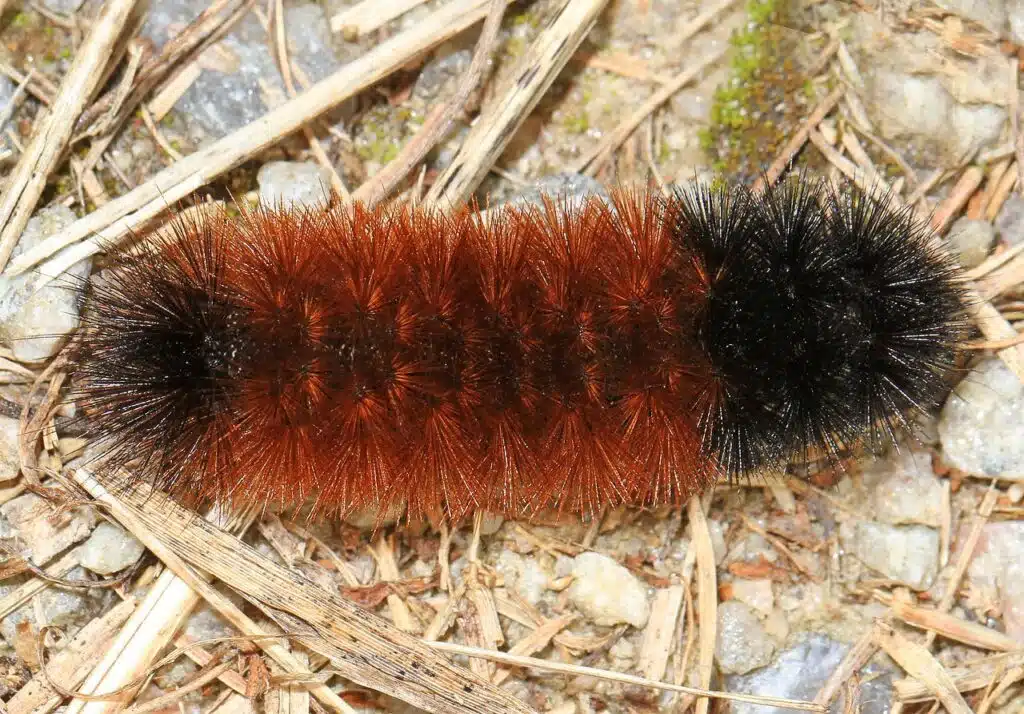
Orange and black sections are specific to this caterpillar (Pyrrharctia isabella). Its long hairs are partly orange and partly black.
Some morphs come in brown and black or in a yellow and black color combination.
These long hairs cause skin irritation in humans.
Caterpillars of this species have a varied diet feeding on different plants and trees.
This varied diet means the caterpillar is present around the world.
This species is also adapted to some of the coolest places around the world.
It survives winters in caterpillar stages. Its overwintering characteristics are based on producing a cryoprotectant that safeguards its internals.
8. Gulf Fritillary Caterpillar
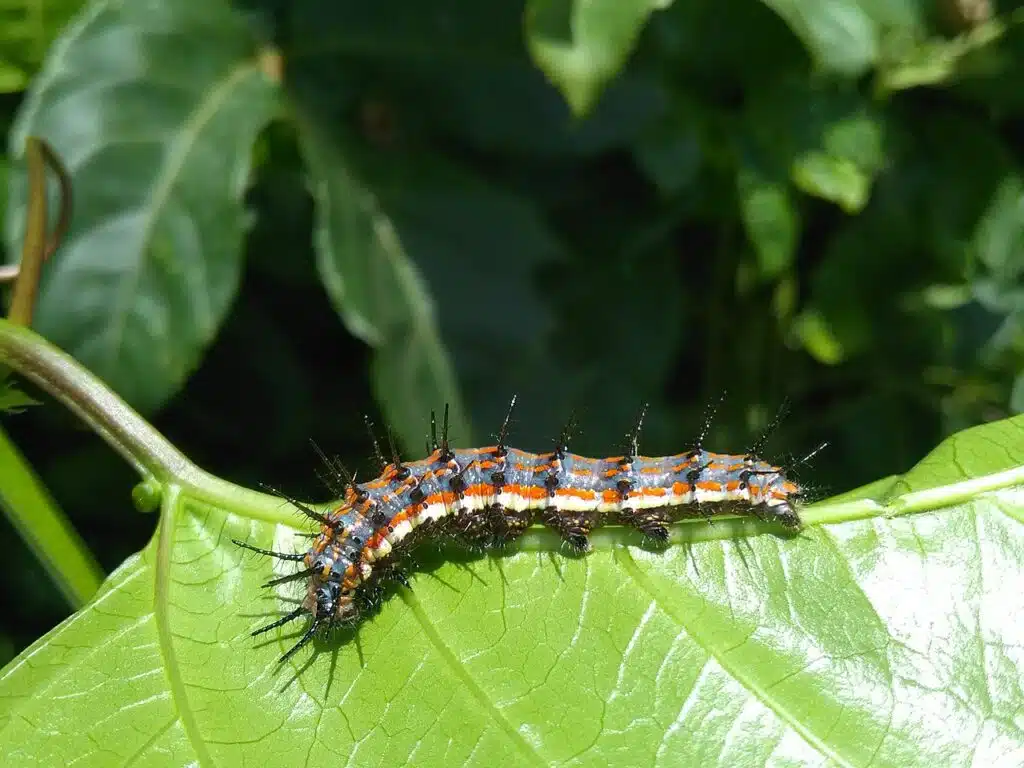
Gulf Fritillary caterpillars (Dione vanillae) have black, orange, and white coloring.
This species also has spike-like black hairs.
Passiflora-genus flowers are the main host of the species. Lantana is one of the flowers the caterpillar can be seen on.
It feeds on the leaves of the host plant.
These caterpillars can be seen on the leaves of lantana during the day. They aren’t as inclined to feed on the underside of the leaves as other species.
Caterpillars of this genus continue feeding on the leaves of plants for up to 2 weeks before reaching the pupal stage.
9. Silvery Checkerspot Caterpillar
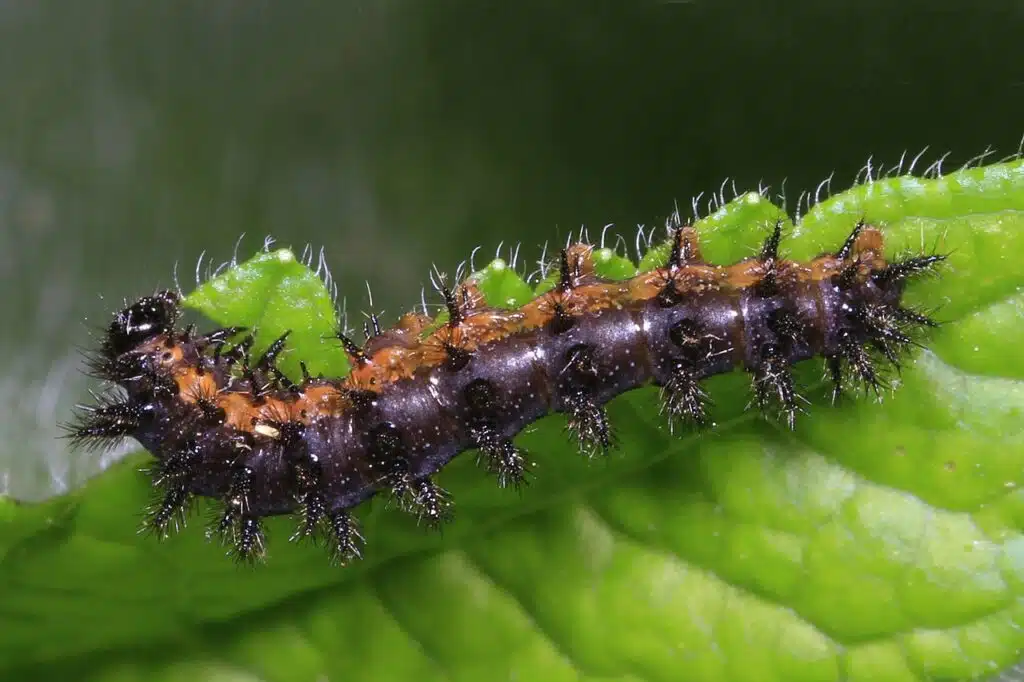
Native to Eastern North American habitats, Silvery Checkerspot caterpillars (Chlosyne nycteis) have black and orange coloring.
Asters, verbena, and wingstem are just a few of the hosts this species has.
It continues feeding on these flowers until it reaches adulthood and when it turns to nectar for food.
Dogbane nectar is preferred by the Silvery Checkerspot adult.
Butterflies have similar orange and black color combinations seen on the caterpillars.
You can find this species across multiple states with small variations in their brood numbers.
The species is only seen in one brood in Northern states.
It appears in up to 4 broods in Texas and other Southern states.
Its season extends to September in warmer climates.
Silvery Checkerspot caterpillars prefer open moist locations where their host plants grow in high numbers.
10. Variegated Fritillary Caterpillar
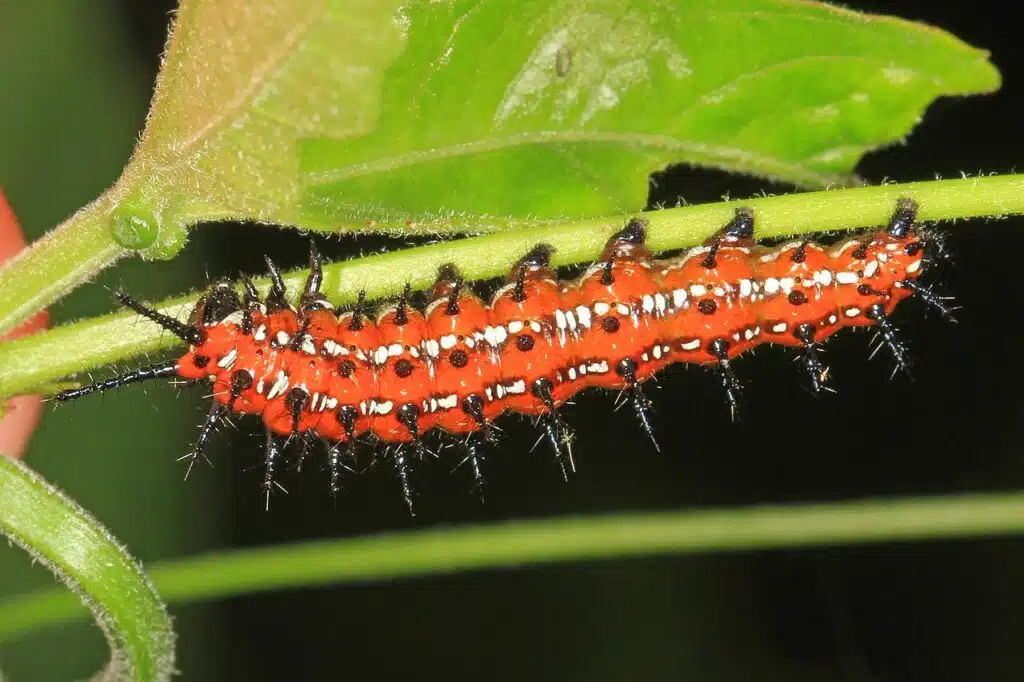
This species of caterpillars (Euptoieta claudia) begin life as a white and orange species. It then slowly turns into a black, white, and orange caterpillar.
Alternating black, white, and orange stripes are seen across its body.
Black bristle-like hairs are seen across its body.
Variegated Fritillary butterflies are migratory. They move South where they overwinter.
Almost all Southern US states are good habitats for the species in the winter.
You can see the caterpillars on a series of flowers, trees, and plants such as alder, plantain, and violets.
Adults move to other food sources such as alfalfa, fleabane, and dogbane.
11. Mexican Fritillary Caterpillar
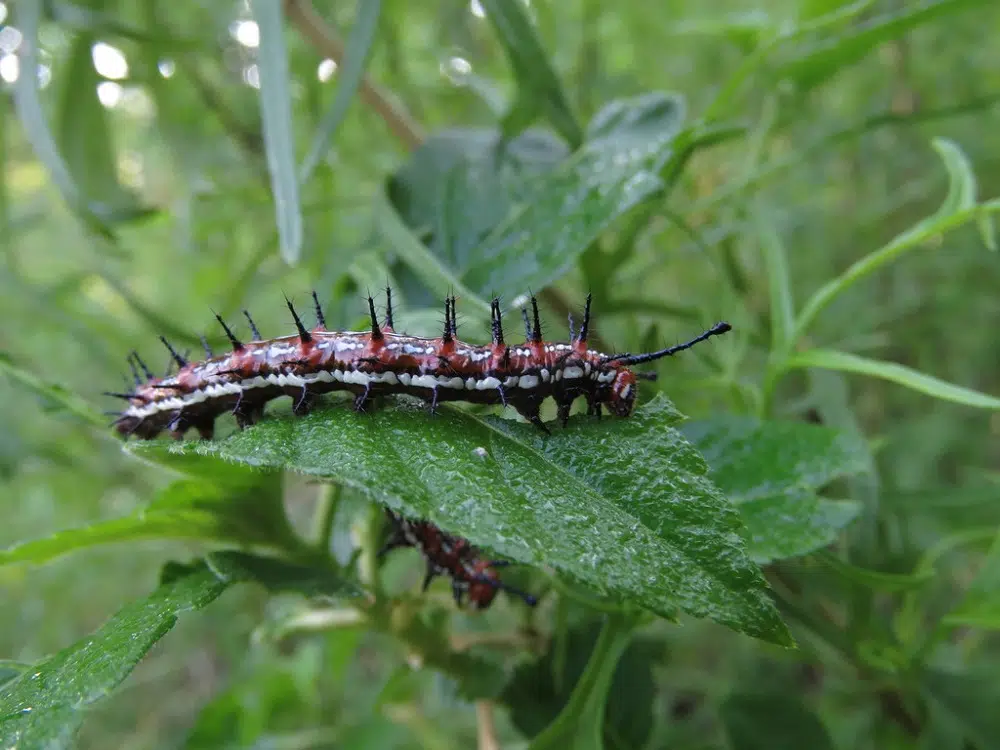
Native to Mexico and The Caribbean, this species (Euptoieta hegesia) also reaches the Southern points of Southern US states.
The caterpillar has very similar colors to the black and orange adult.
These caterpillars have dark orange, black, and white coloring.
Orange nuances on these caterpillars are darker. Some caterpillars may even appear brown and red.
The body of the caterpillar is mostly orange. It has a central dorsum white stripe and multiple black dots on the sides. Other white stripes are seen on its lower lateral sides.
Short to medium-length black bristles are seen in this species. Its antennae are also black.
Seen in remote areas of Texas and Arizona, this is a caterpillar that feeds on passionflower and multiple other violets.
12. Garden Tiger Caterpillar
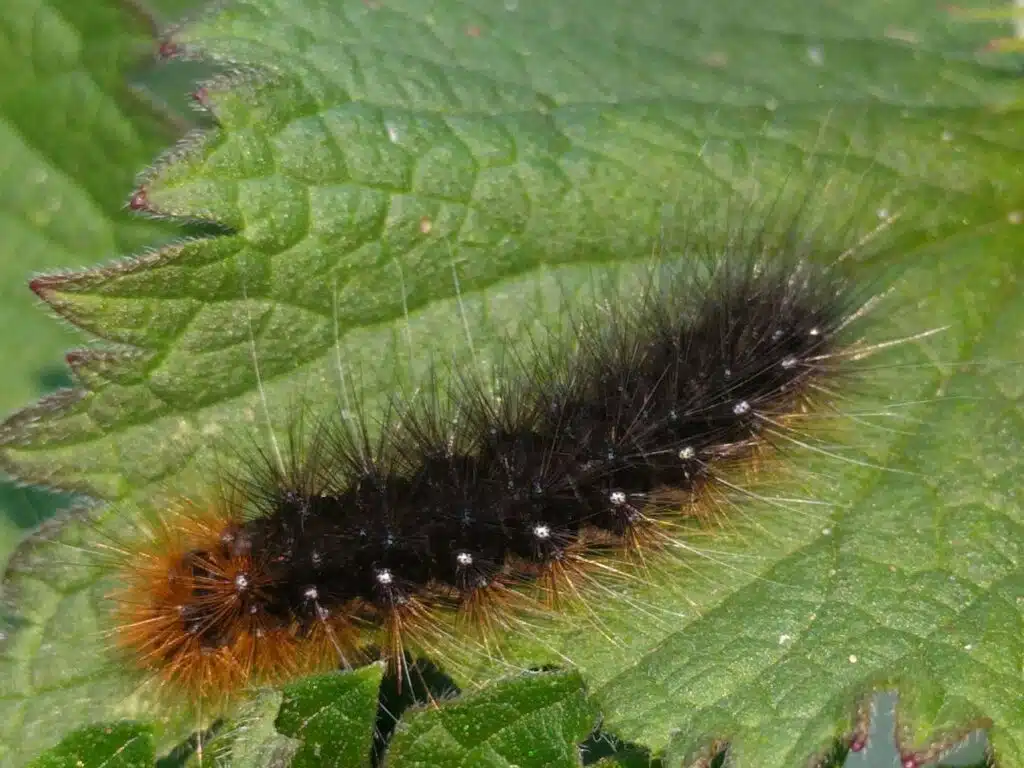
These caterpillars (Arctia caja) are dominated by long black hairs covering the dorsal side and orange hairs seen on the lateral sides.
There are no other colors or patterns across the body of the species.
Native to North America and Europe, Garden Tiger caterpillars have a long list of host plants.
They can thrive on any type of plant, especially those high in toxins.
It absorbs plant toxins which give it its popular bad taste that makes bird predators keep their distance.
These caterpillars feed on plants such as foxglove.
Once adults, Garden Tigers maintain black and orange coloring with white forewings.
This species remains nocturnal and elusive despite its common nature on a wide range of host plants.
13. Milkweed Tussock Moth Caterpillar
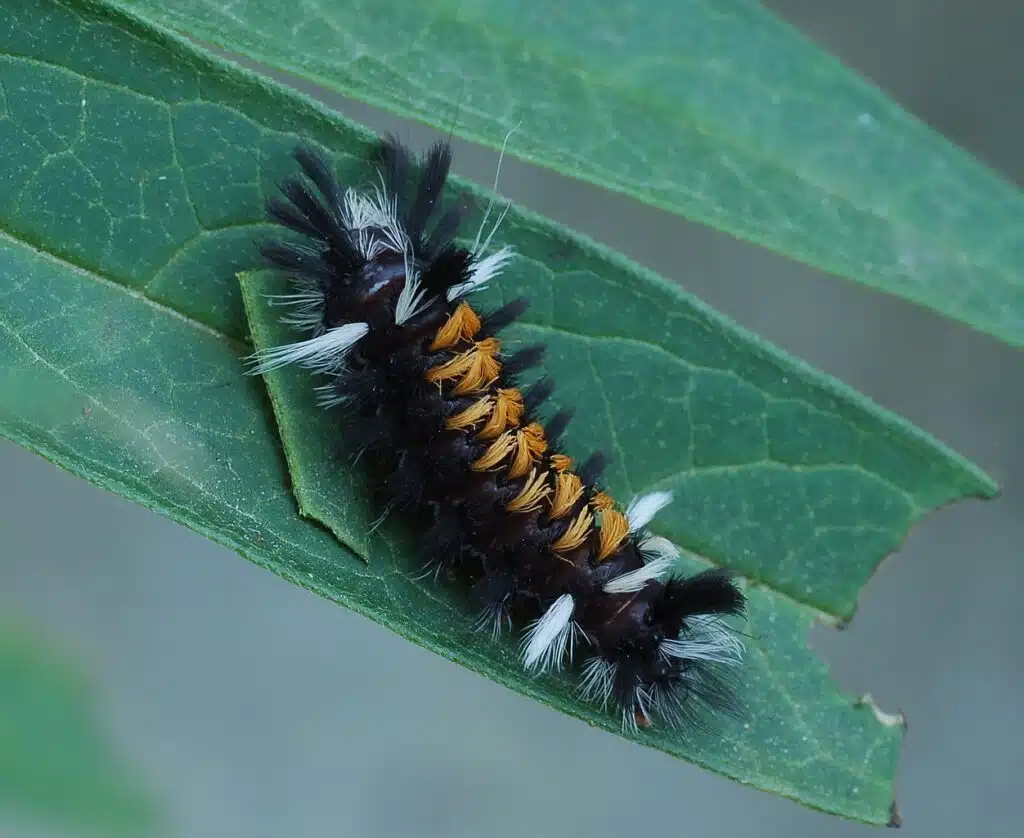
Moths of this category are among the most common when it comes to tufts across the body.
They (Euchaetes egle) are known as black caterpillars with considerable orange sections and even white tufts that decorate its body.
Long hairs that grow in different directions cover its body. The species is black with a wide orange section across the dorsum.
These caterpillars also show white or gray hair tufts on the body.
Native to Eastern North America, the species used milkweed as a host.
You can see these caterpillars on milkweed in Northeastern states in their highest numbers.
Once adults, the caterpillars darken in color and only show their black bodies and black forewings.
14. Long-winged Dagger Caterpillar
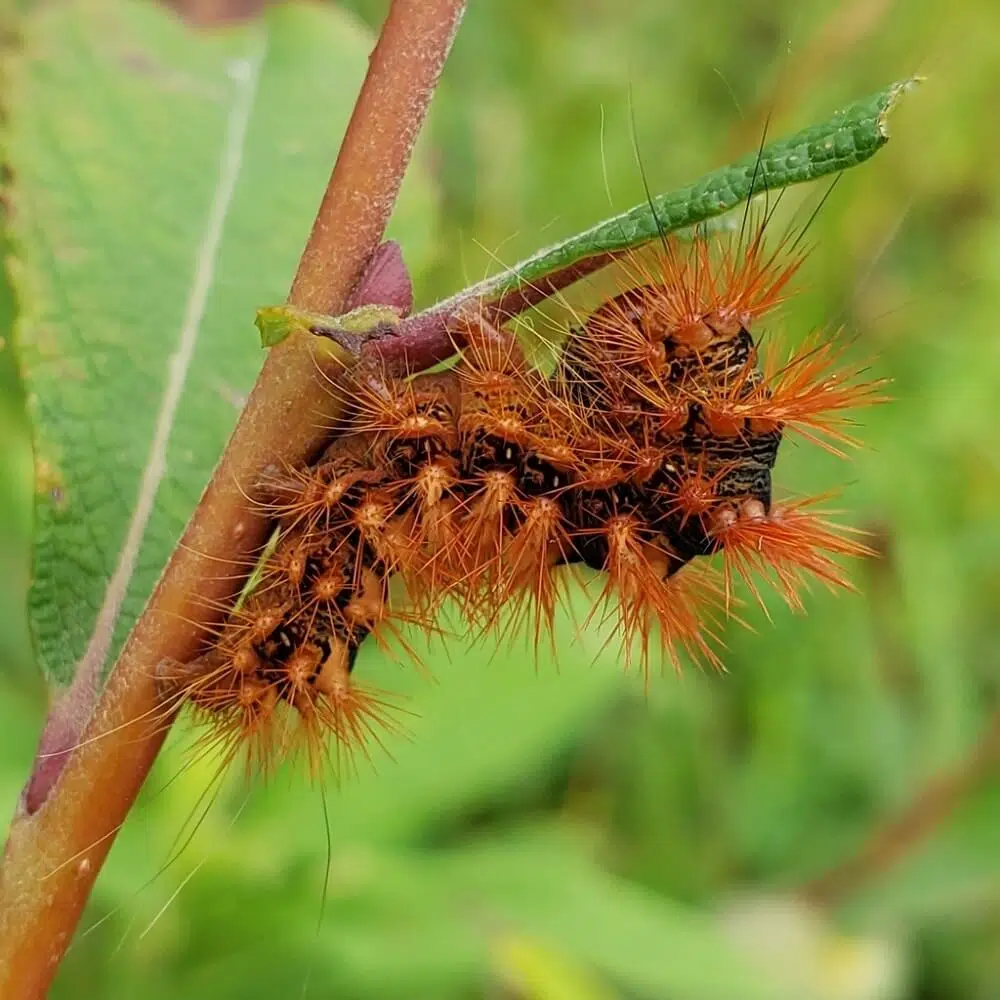
Long-winged Dagger caterpillars (Acronicta longa) are known to have orange and black coloring across the instars.
The nuance and the percentage of the body covered in these colors vary according to its instars.
A mostly red caterpillar is seen in the first instars. Only a few black stripes are seen along its body
in these growth stages.
Orange nuances can be vivid or orange-red in their first instars.
Black sections start to appear across its body once the caterpillar moves into its late instars.
A central black stripe and multiple black bands across its body are then seen as the caterpillar matures.
Oak is one of the host trees of the species.
You can also see the caterpillar on blackberry across Northern parts of North America.
15. Faithful Beauty Caterpillar
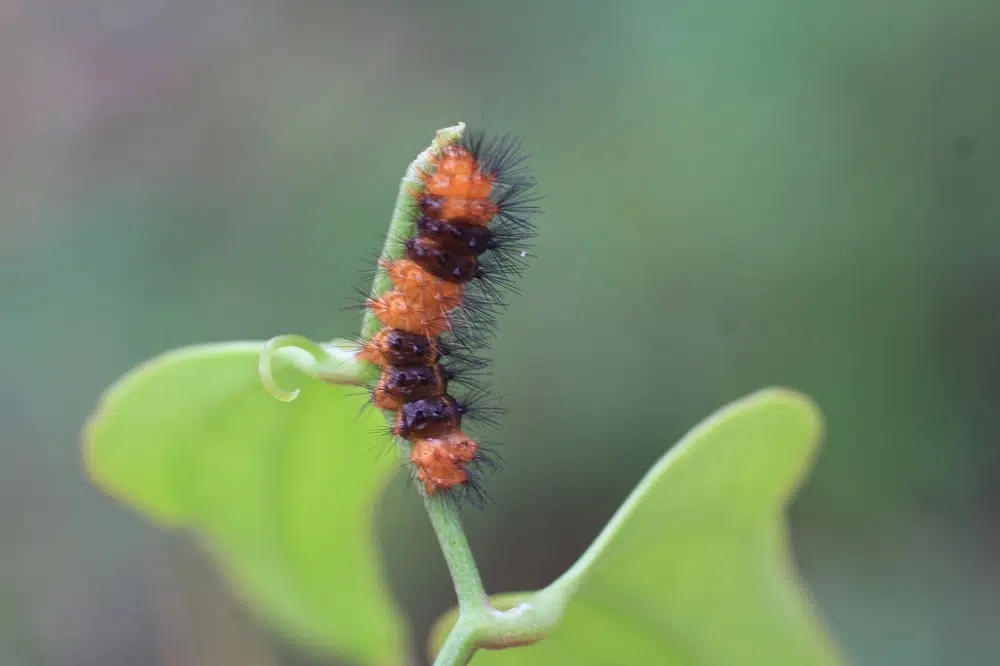
Oleander and jack beans are some of the most common hosts of the Faithful Beaty caterpillar (Composia fidelissima).
This is a species that has a select range of hosts that also has distinguishing orange and black colors.
Red and black color combinations are also common for the caterpillar.
This species is initially mostly orange. Black sections tend to cover its body as it grows, within a few days.
Short hairs are specific to the orange sections of its body while black sections are characterized by longer hairs.
Some caterpillars also show tiny black dots across the orange section.
This species maintains some of these colors and color combinations as an adult. Black sections are seen across its forewings and hindwings.
16. Pawpaw Webworm
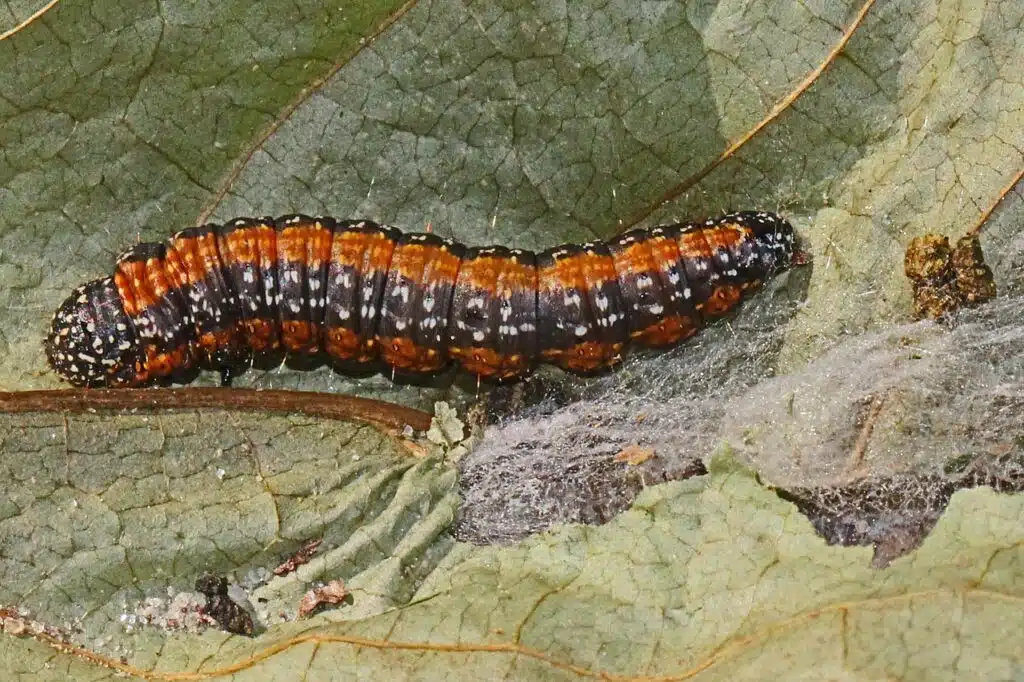
Pawpaw Webworm caterpillars (Omphalocera munroei) are damaging species in the Eastern United States and Eastern Canada.
These caterpillars rely on pawpaw as a host and they are living in the same habitat where these trees grow.
Damages to the trees are considerable.
Mostly seen in August and September, these caterpillars need to be removed as they can eat pawpaw leaves completely.
A base black color is specific to the species. A wide orange band is further seen across its body.
Tiny white spots are also specific to the species. These white spots are seen both on its black and its orange sections.
17. Pine Conelet Looper Moth Caterpillar
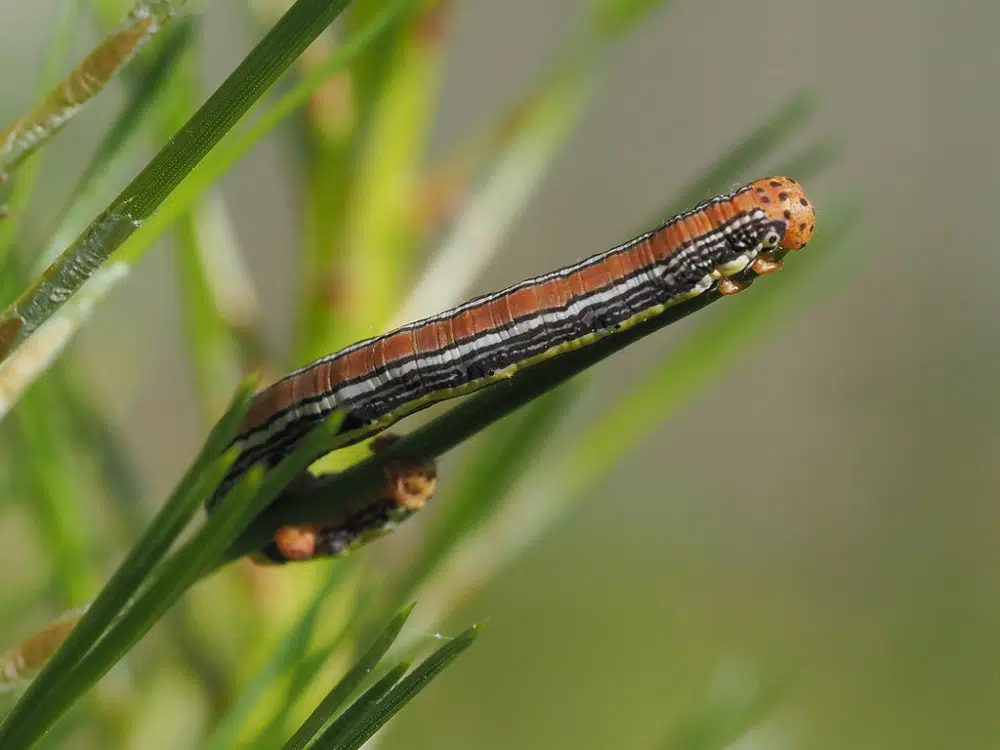
Orange is the main dorsal color of this caterpillar (Nepytia semiclusaria). A wide orange band covers the dorsal side of the species while alternating black and white stripes are seen on its sides.
Some morphs also show yellow stripes and yellow ventral color.
These caterpillars don’t share the same colors into adulthood. Adult Pine Conelet Looper Moths have tan or light brown coloring.
You can see these caterpillars in the US, particularly in the Southeastern states.
Florida is one of the states with high numbers of Pine Conelet Looper Moths, followed by North and South Carolina.
18. Clemens’ False Skeletonizer Caterpillar
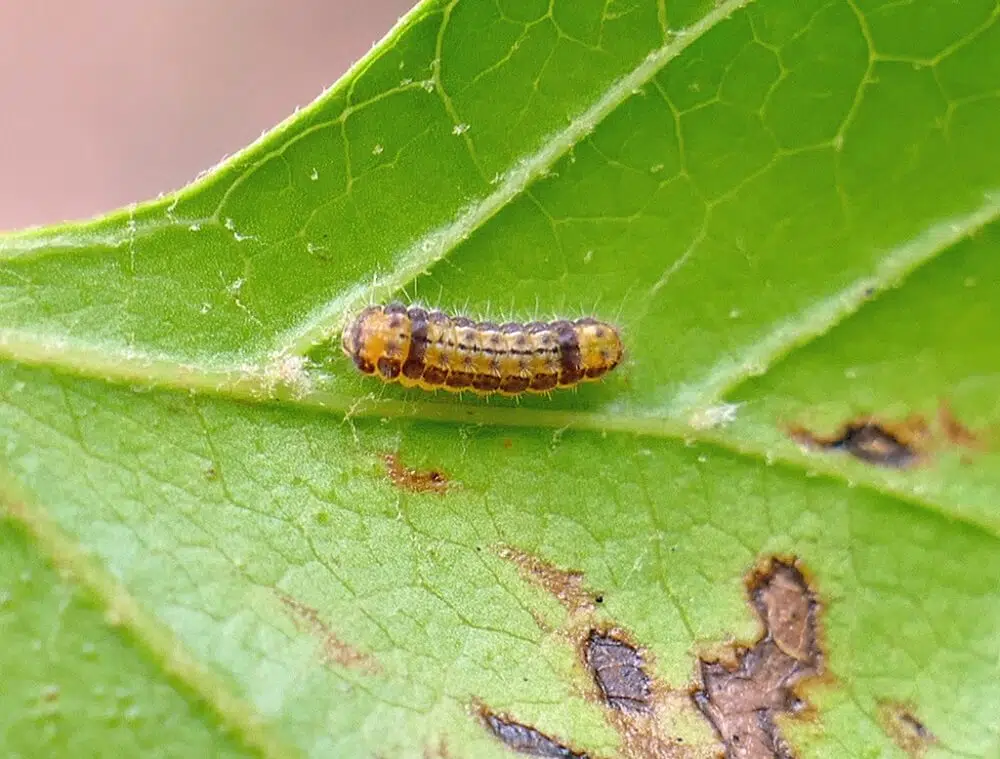
Peppervine and Virginia creeper are some of the most common hosts of these colorful caterpillars (Acoloithus falsarius).
Adults are known to feed on grapes.
Like most orange and black caterpillars, Clemens’ False Skeletonizer caterpillar goes through various color changes through its instars.
The species is initially orange.
Black sections start appearing on its body later on.
A narrow black band is seen on its dorsum.
Wider black bands are seen on the sides of its body.
This moth species is also known for maintaining its colors from its caterpillar stage into adulthood.
Adult Clemens’ False Skeletonizer moths have a black color with orange sections that resemble neckbands.
You can find this species across multiple US states as well as throughout Mexico.
19. Pacific Tent Caterpillar
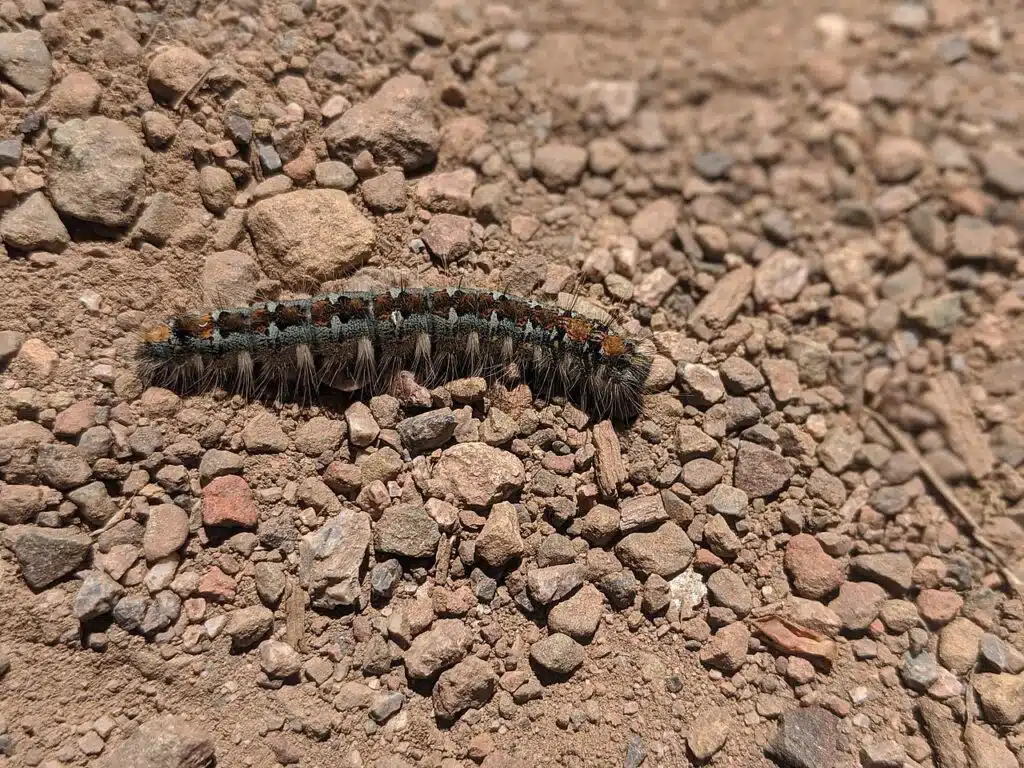
Pacific Tent caterpillars (Malacosoma constricta) are seen across California. This species lives in habitats at various altitudes from Sacramento to San Diego in the South.
Black and orange is a common morph of the species, as is black and red. A wide orange band is seen across the dorsal side of the caterpillar. Black sides are specific to the species.
Yellow tufts are further distinguishable across their lateral sides.
Multiple tiny white dots are further identifiable on the black sections of its body.
Various plants and trees are common hosts for the species.
Coast Live Oak and Blue Oak are among their common hosts.
California Wild Rose is one of the host flowers of the species.
These host species are shared with many other caterpillars, butterflies, and moths across California.
Golden Hairstreaks are commonly seen on these oaks which means the total number of species on the tree might be damaging to the host.
You can find this caterpillar on trees in full sun in dry habitats across Coastal California.
20. Apantesis incorrupta
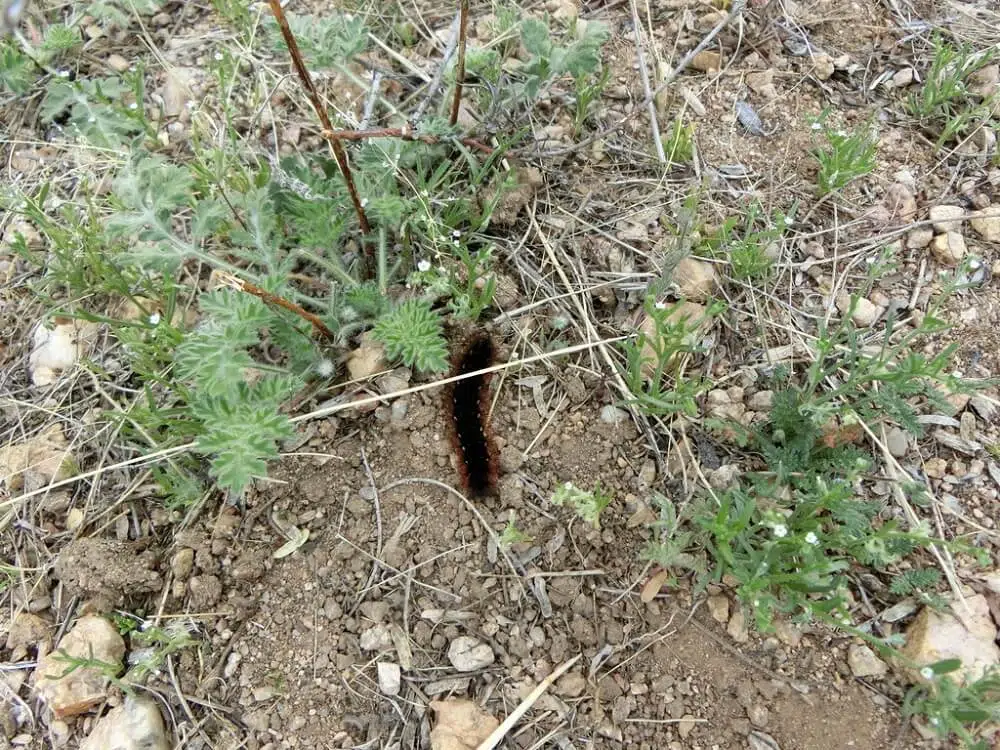
Orange and black colors dominate the hairs on this species of caterpillars. As for adults, orange and black sections cover most of the body.
The dorsal side of the species is black with red lateral colors and hairs.
You can find these caterpillars in Southwestern US territories as well as in Western Mexico.
The species is common across Texas, Arizona, and Utah.
This species is known to be among those that feed on herbs and herbaceous plants.
Apache plume is among the wild herbaceous plants this caterpillar feeds on.
This flower is found in grasslands and it may also be found across the edges of woodlands.
Researchers are looking into caterpillars of the species for supposed evidence of self-medication in the world of insects.
Caterpillars eat certain types of leaves with compounds that fight parasites. This feeding habit is deliberate and it makes this the first species to consume leaves that promote healing.
21. Ranchman’s Tiger Moth Caterpillar
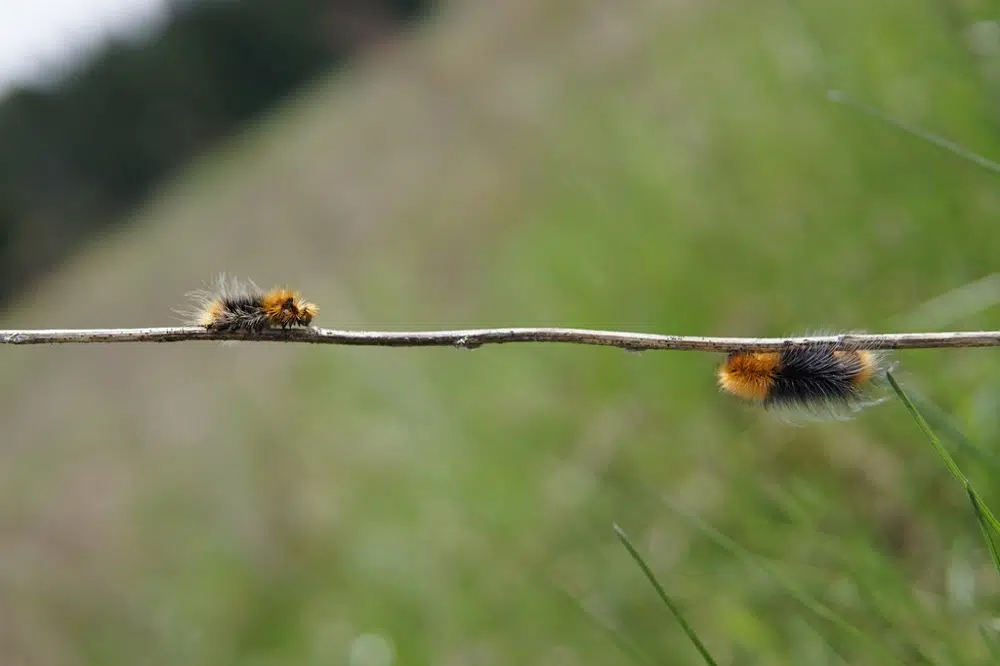
This orange and black caterpillar (Arctia virginalis) is native to Western North America.
It has a numerous presence in California, Utah, and North to Canada.
Apart from its hairy black and orange body, this species is also known to maintain its coloring through adulthood.
The adult moth has a yellow or yellow-orange color of the hindwings with black and white forewings.
As the adult, the caterpillar is tied to riparian zones within its Western habitat.
It only lives in areas with plenty of moisture, mainly close to water.
Wet meadows are among the habitats this species likes the most.
The species lives at various altitudes where herbaceous plants grow.
You can see it feeding on leaves and going through multiple coloring changes from one instar to another.
While it begins life as a black caterpillar with an orange head, it reaches a late instar stage with multiple orange spots across the body.
22. Wood Tiger Caterpillar
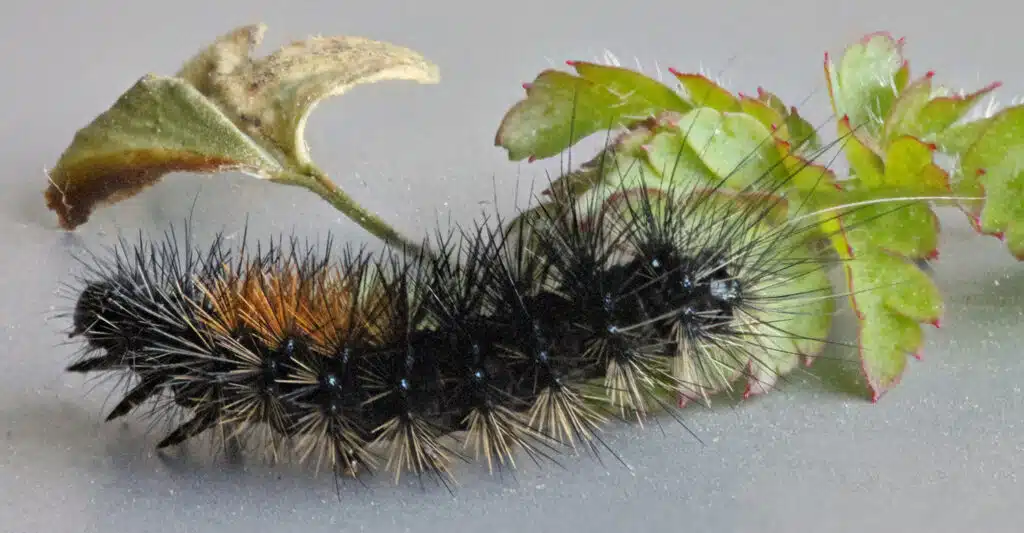
The caterpillars of Wood Tiger moths (Arctia plantaginis) are among the most common black and orange species in North America.
An extended diet is specific to these caterpillars which have the role of gaining all the nutrients the species needs as adults don’t feed.
Various species of herbaceous plants are used as a host by the caterpillar. It extracts nutrients that make it taste bad for predators from these plants.
These caterpillars are mostly seen in riparian areas or zones next to water sources across North and Central America.
Caterpillars of the species can also survive habitats at higher altitudes, especially those close to streams or ponds.
They feed on lupine species growing in these areas.
Once the adult moth emerges, it also bears the colors of the caterpillar.
Orange and black are dominating colors in adults, as is white.
23. West Indian Mangrove Buckeye Caterpillar
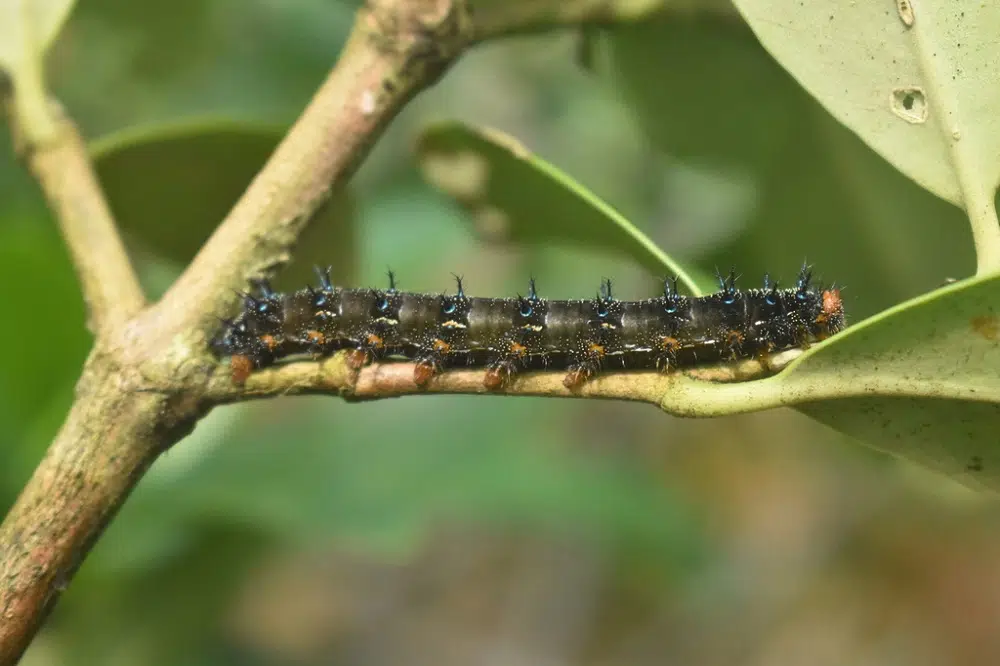
This species of caterpillars (Junonia neildi) have a black dorsum with long dark hairs and orange sides.
Some of the colors of the caterpillar are further seen on the adult butterfly.
Adults of this species are mostly brown, but they use the black and orange colors of their caterpillars for defensive purposes.
They have a wide orange band across the wings which highlights their large black eyespots. Black and orange colors dominate the margins of its wings.
West Indian Mangrove Buckeye caterpillar lives in Southern Florida, Texas, and The Caribbean.
The species is also common in South America.
Wild petunias are among the multiple hosts of the species.
24. Spiny Oakworm
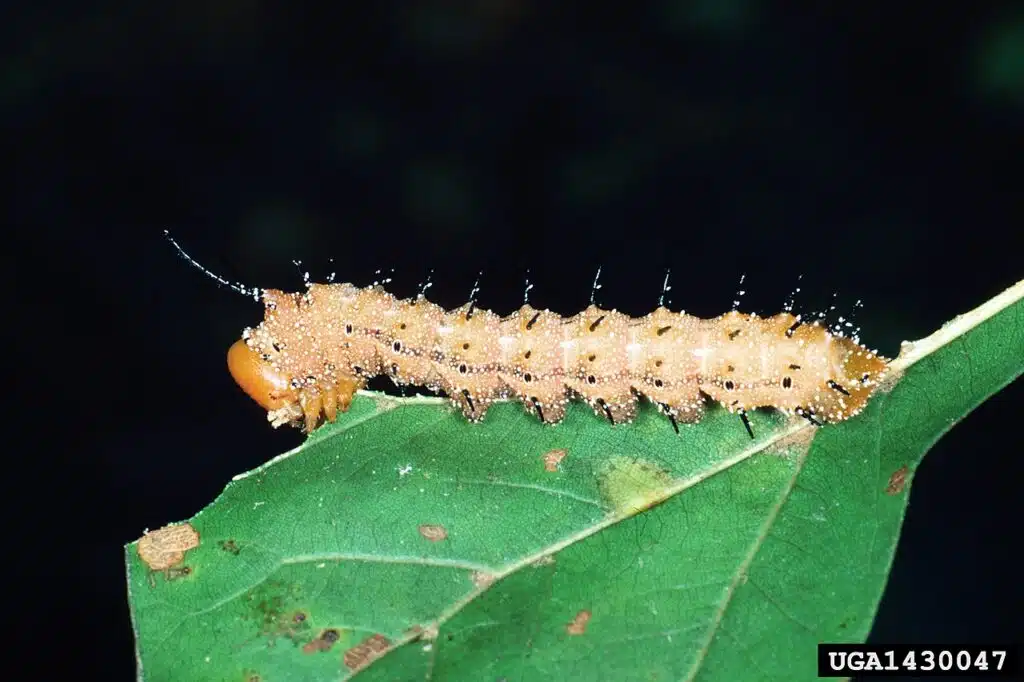
Orange and black colors are specific to the Spiny Oakworm caterpillar (Anisota stigma). This is a species that has a pale orange base color.
Black dots and a few black filaments are seen on the species. Tiny white spots are further distinguished across its body.
The role of these black and white dots is to make the caterpillar appear dangerous or poisonous, while it’s not.
Common on the Eastern Coast in states such as Florida and Northern habitats up to Canada, this caterpillar uses oak as a host tree, as its name implies.
On occasion, these caterpillars move to other hosts outside oak woodlands. Hazel is one of the trees they can settle on as an alternative.
Orange is the main color of this species across all of its life stages. Adult moths have dominating light and dark orange colors across the body and the wings, just like the caterpillar.
The eggs of the species can be white, yellow, or orange as well.
25. Rusty Tussock Moth Caterpillar
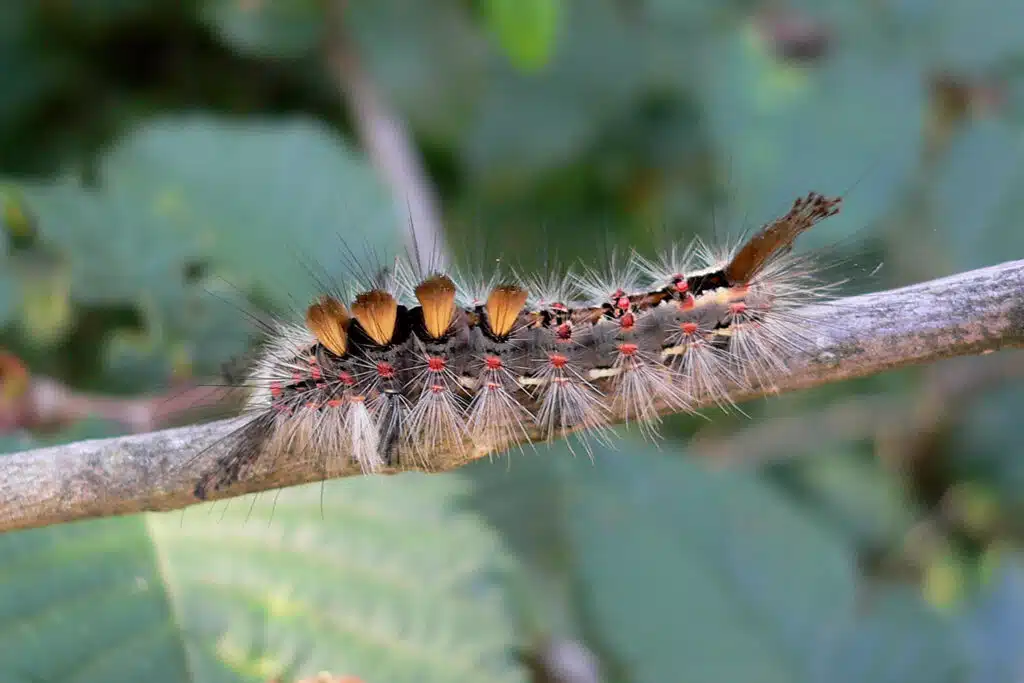
Rusty Tussock Moth caterpillars (Orgyia antiqua) are quickly identified by their 4 white defensive glands on the dorsum.
These glands have toxins in them and hairs are rubbed against them to charge more toxins.
Known for causing skin irritation, this caterpillar should not be handled.
The coloring of the species is based on a black base nuance. Orange sections and red sections are also common.
Orange tuft hairs and white long hairs are further distinguished across its body.
This species is tied to all types of host species such as trees and plants.
You can see it on birch, lime, willows, and other fruit trees.
Growing to a size of up to 40mm, the species is mostly seen in the summer.
Its season can expand to October in certain parts of the world.
These caterpillars appear soon after the last frost of the season. You can see these caterpillars once leaves appear on trees early in the season.
26. Cactus Moth Caterpillar
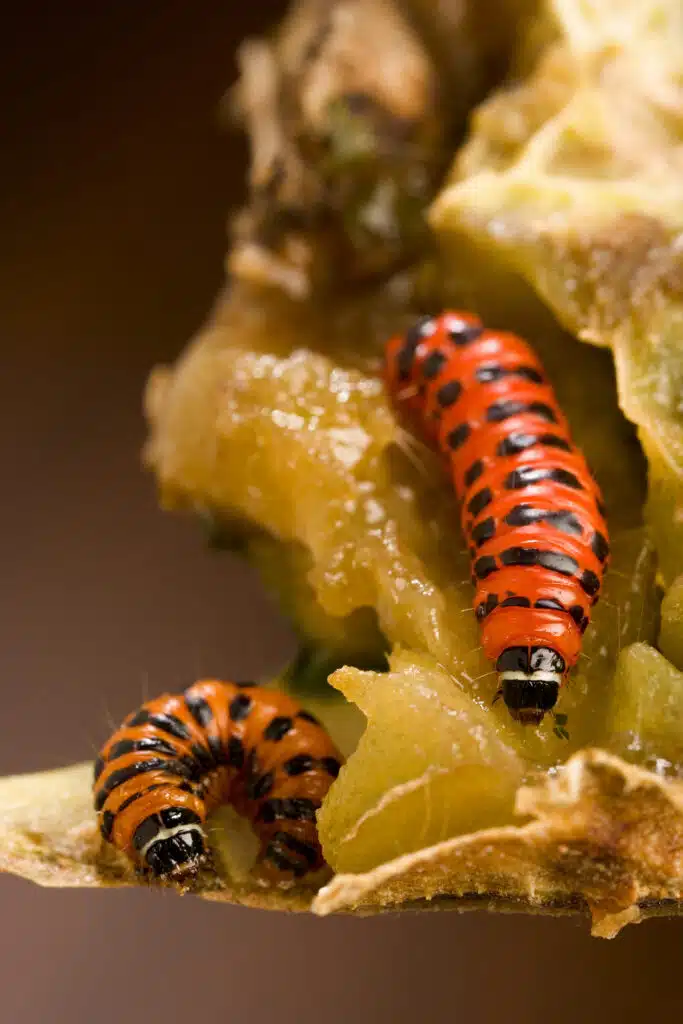
These types of caterpillars (Cactoblastis cactorum) have a complex history in North America and across the world. They have been introduced to The Caribbean and they’ve since spread to Southern US states.
They inhabit large areas of Florida and other Southern states such as Texas.
In South America, the species is a known food for various monkeys.
As their name suggests, these caterpillars grow on various cacti. Not all types of cacti are suitable for these caterpillars as female moths spend a long time finding suitable hosts.
The caterpillar is dominated by orange and black coloring.
Orange is the main color of the body while multiple black bands are seen from one end to another.
This species can be beneficial in controlling invasive cacti species.
While this isn’t the case in North America, it was noted across Australia.
In turn, these caterpillars can be partially controlled by predators such as wasps and ants.
27. Silver-spotted Tiger Moth Caterpillar
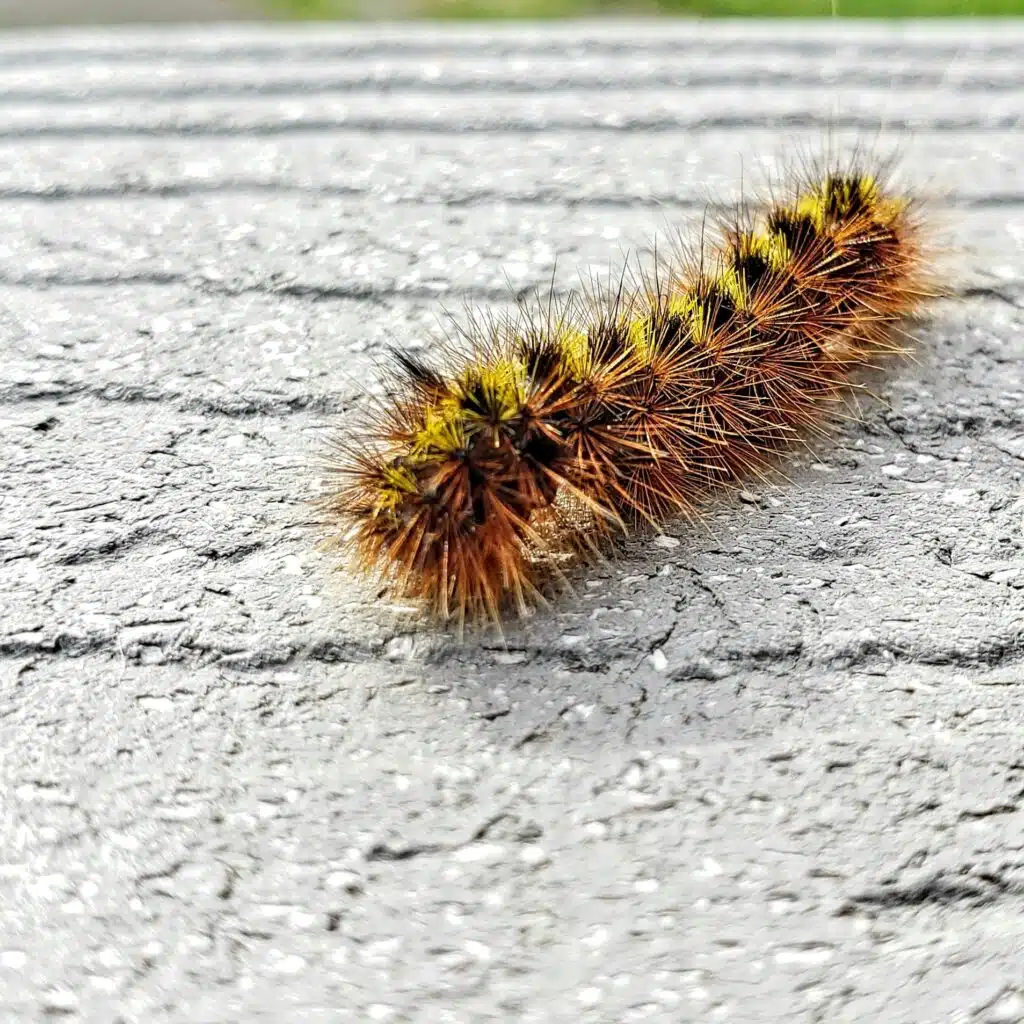
Silver-spotted Tiger Moth caterpillars (Lophocampa argentata) have a black base color with orange hairs. These orange hairs are only visible on their sides.
The species has a few yellow marks across the body as well.
Known for its 4 black tufts on the sides of the body, this is a species native to Western US territories.
You can find the caterpillar in California, Nevada, and Utah, among other states.
Its habitat is closely tied to pine trees so its range is limited to higher elevations.
Douglas fir or Colombian pine is the host species of the moth.
As an adult, the moth carries on some of the colors seen on the caterpillar, through its instars.
A combination of orange and yellow colors characterizes this species.
You can identify the adult moth by its dark orange body. The nuance resembles the orange hairs of its caterpillar.
28. Orange-tipped Oakworm
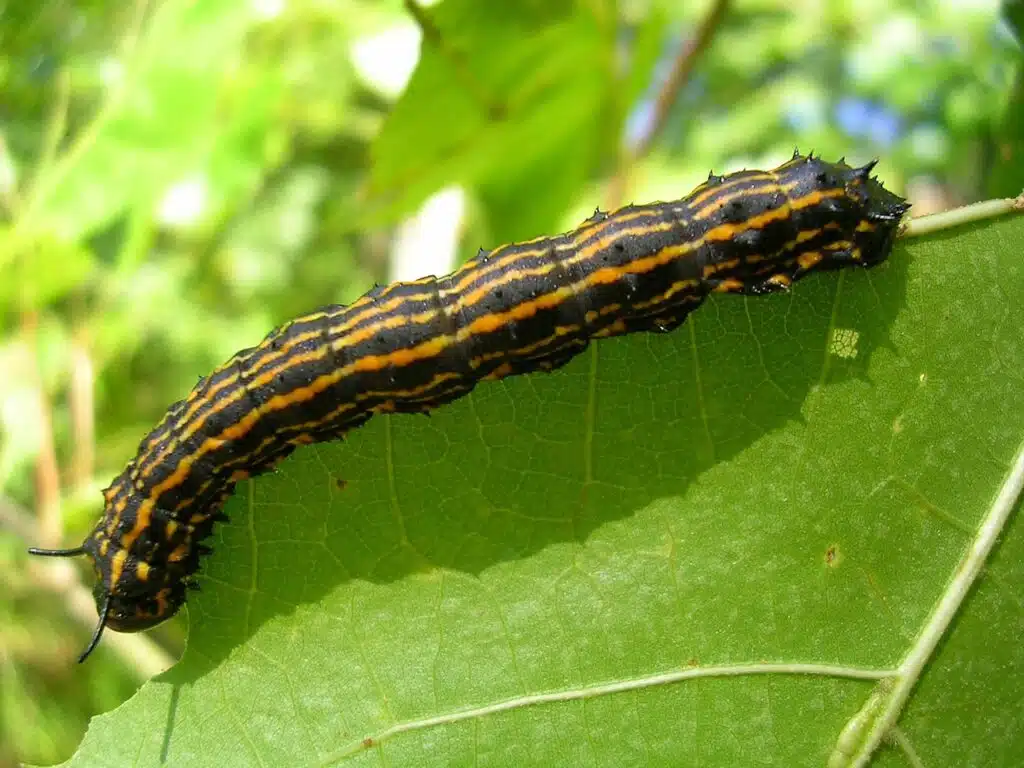
Alternating black and orange stripes are seen on the Orange-tipped Oakworm (Anisota senatoria).
This species only has black and white colors across its body in its final instars.
Otherwise, it has dark green or black stripes with orange alternating stripes across its body in its first instars.
You can find this species feed on oak tree leaves.
Damages to the trees tend to be localized as the caterpillar doesn’t move as much as other species in its late instars.
However, complete skeletonization of leaves is possible on certain branches where multiple caterpillars feed.
This species has small black spikes on the back which might make it look poisonous, but it can be removed by hand.
Insecticides are recommended on large oaks as manual removal isn’t possible otherwise.
The highest risk of defoliation comes in August and September, the months this species multiplies in rapidly.
29. Unexpected Cycnia Moth Caterpillar
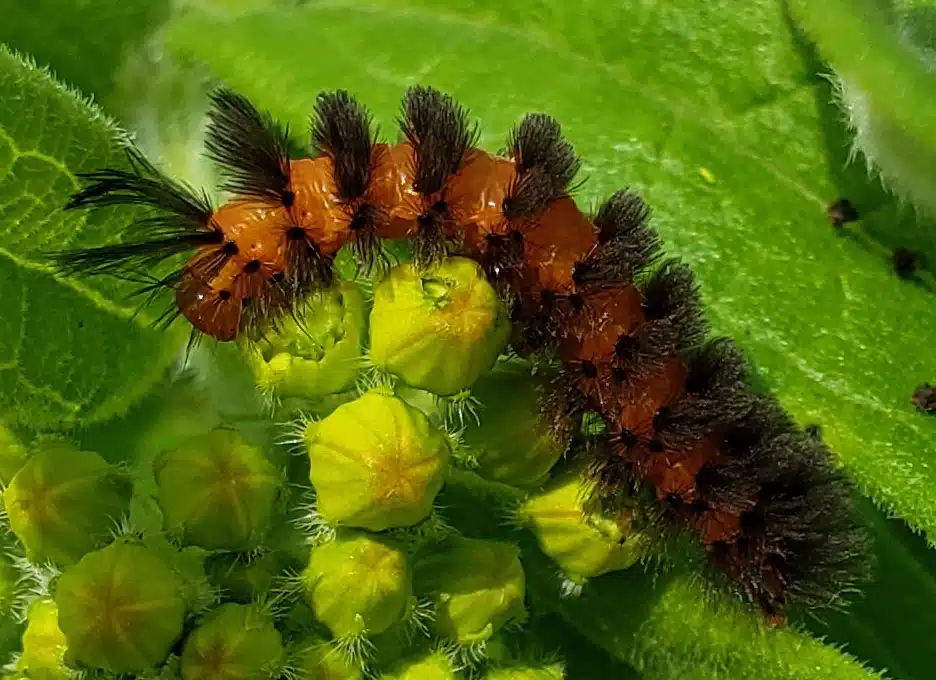
These types of caterpillars (Cycnia collaris) are native to the US. They have a widespread presence, particularly on the Eastern side of the country.
Orange and black colors are specific to the species. A base orange color with black tufts and black hairs is seen on these caterpillars.
They are orange throughout each instar.
You can find these caterpillars feeding host plant leaves. Milkweeds are their preferred host.
Butterfly weed is often the only host species the caterpillar is seen on.
Adult moths of the species don’t carry any of the colors of the caterpillar. Adults are white or cream-white.
30. Buck Moth Caterpillar
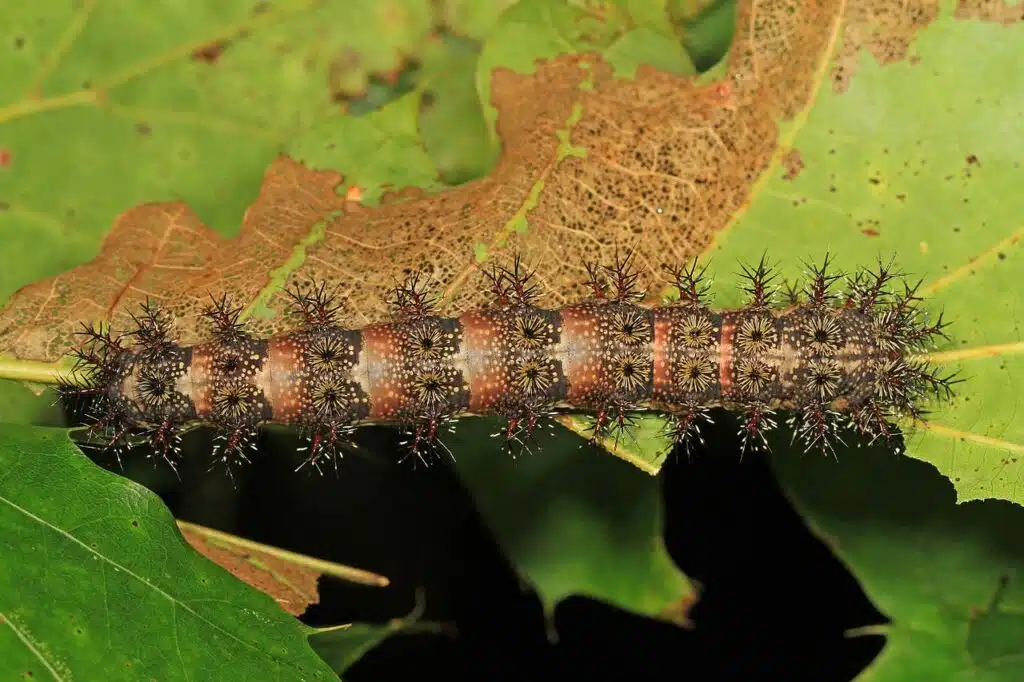
Buck Moth caterpillars (Hemileuca maia) have long hairs that get stuck in the skin if you touch them.
These hairs are connected to venom glands which trigger different types of skin reactions.
One of these reactions is red skin. In the more severe cases, they trigger itching and pain that lasts.
These caterpillars have a black, gray, and orange color in late instars.
They are found throughout California and in other coastal states up to Maine.
Multiple trees and plants are noted as possible hosts. Oak trees are a common type of host given the common nature of these trees in the Eastern sides of North America.
Adult moths of this species carry some form of coloring from their caterpillar stage.
They have a gray to black upper body and a vivid orange lower body.
31. Eastern Tent Caterpillar
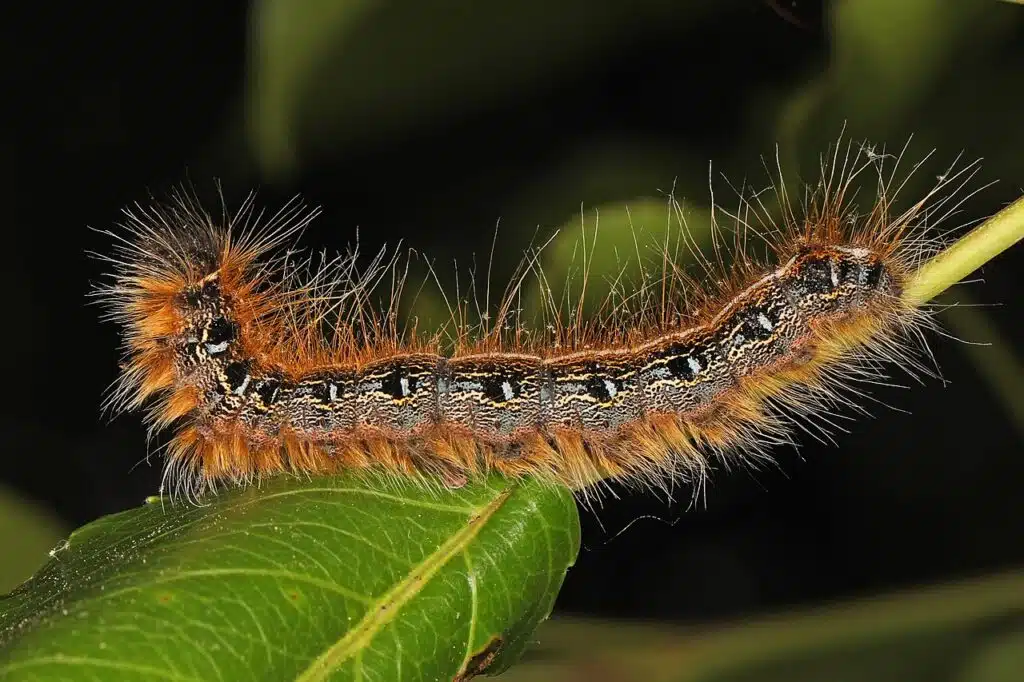
Eastern Tent caterpillars (Malacosoma americana) build silk structures resembling tents. These defensive structures cover one or more caterpillars and the leaves of a host as a protective barrier.
You can identify this species by its base black color with orange marks. Blue dots are also seen on the dorsal of the species.
A central white stripe is also characteristic of the dorsum of the species.
These caterpillars feed on wild black cherry trees, a species known for their toxins.
These toxins are absorbed by the caterpillar defensively.
So many toxins are inside a single caterpillar that they can be considered detrimental to animals eating this species.
Horses are particularly vulnerable to this species.
A pregnant mare will abort soon after eating a caterpillar due to its toxins.
32. Yellow-winged Pareuchaetes Moth
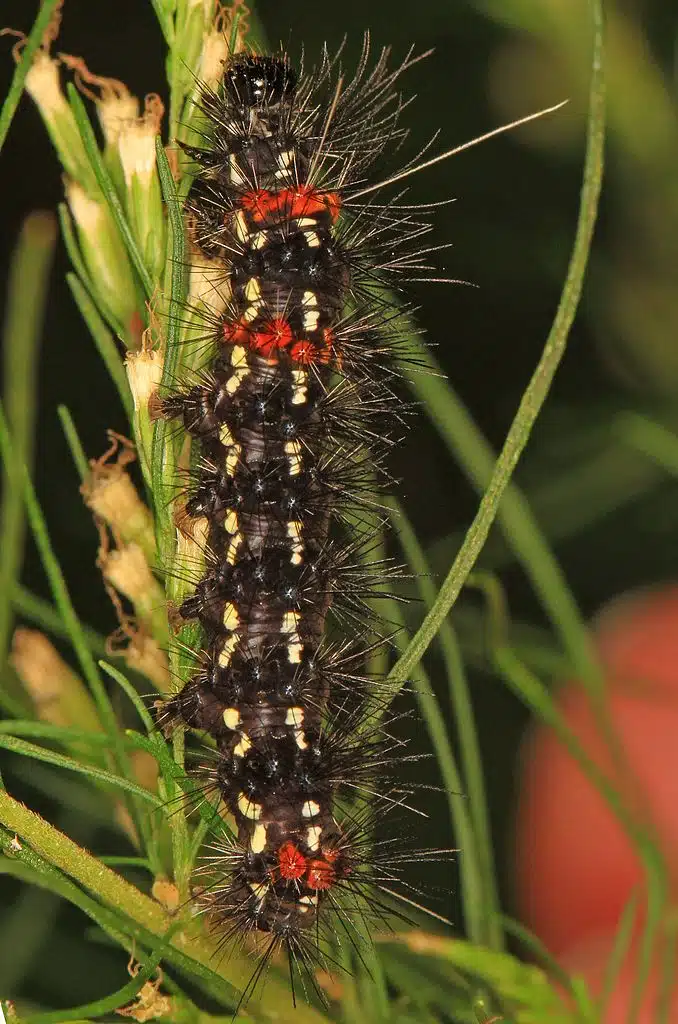
These orange and black caterpillars (Pareuchaetes insulata) are only found in Florida and Southern Texas within the US.
You can also find them in Mexico and The Dominican Republic.
Colorful and rarely seen outside tropical climates, these types of caterpillars feed on asters.
They can also feed on whiteweed.
Adults carry some of the colors of these caterpillars. A white upper body and a pale orange body are specific to the adult moth.
Its wings are white, on the other hand.
33. Legume Caterpillar
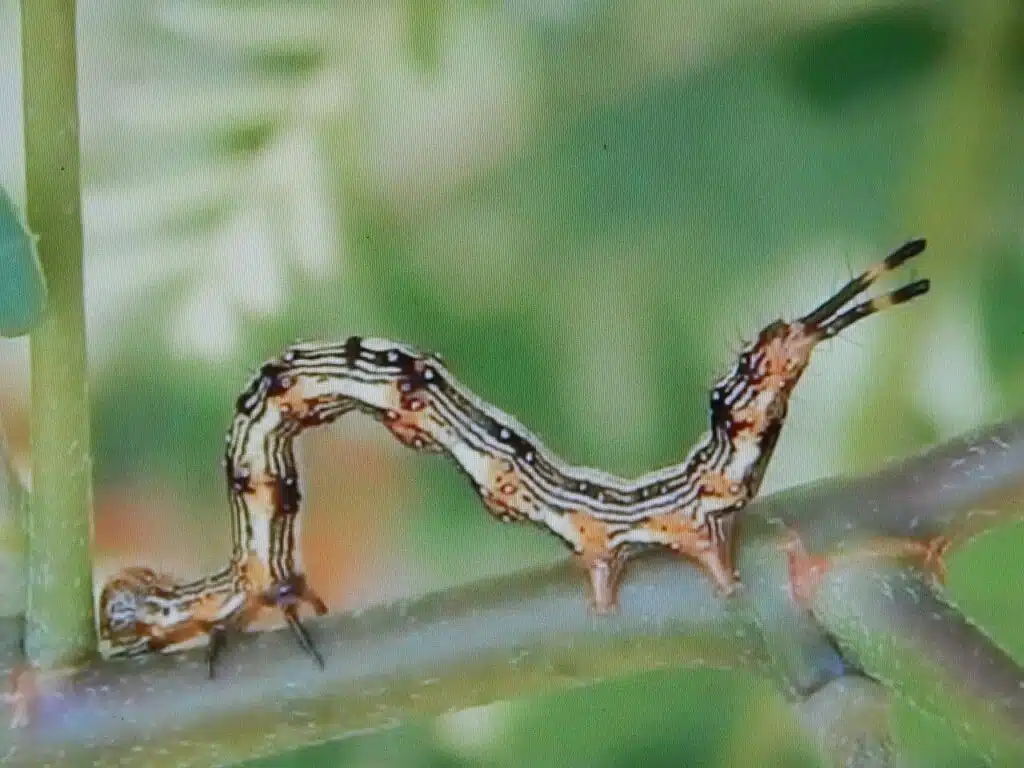
A wide range of legumes are hosts for the Legume caterpillar (Selenisa sueroides). A common sight on North American crops, the caterpillar has a highly damaging role.
This role is impacted by its defoliation and by its ability to escape predation through mimicry.
It has a dark color with black and orange nuances that also feature white and gray areas on a body shaped like a twig.
Largely elusive to predators, this caterpillar species are among the most common on commercial crops.
Since they can eat the leaves of multiple legumes, you also need to use insecticides on the legumes in your garden against them.
The species eventually becomes an adult that also uses mimicry. Adults of the species have light and dark brown coloring resembling logs or tree bark.
34. Baltimore Checkerspot Caterpillar
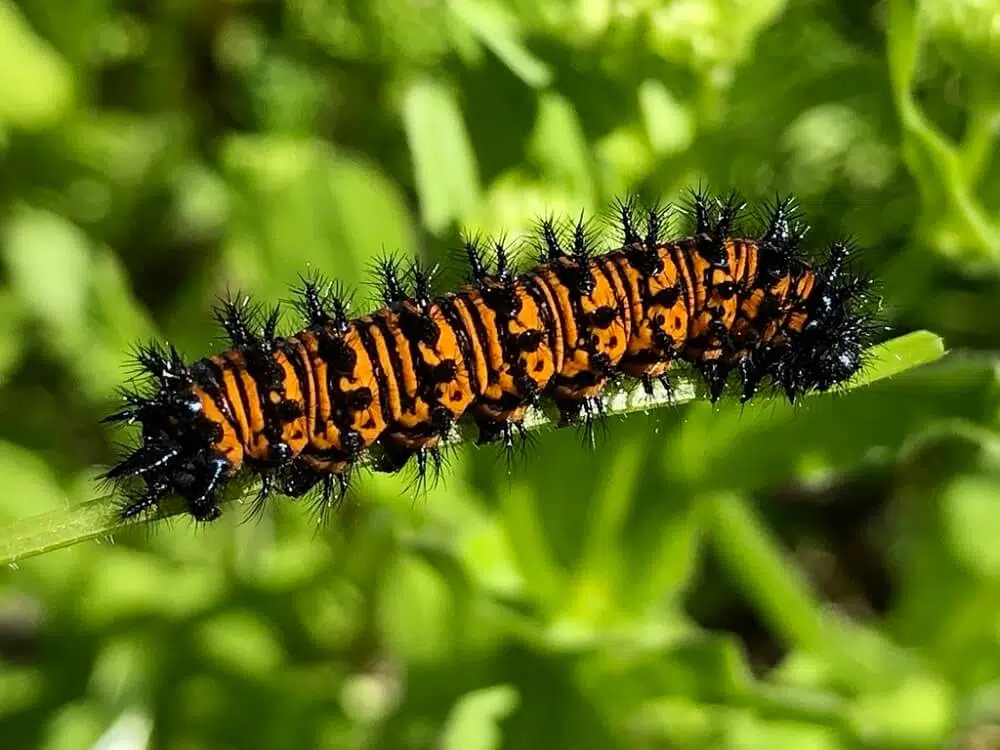
This species of caterpillars (Euphydryas phaeton) are seen across both wet and dry habitats in Eastern North America.
It represents a species with very specific host plant preferences. Plantains are among its preferred hosts.
Like other caterpillars, this species begins life as a white caterpillar with orange and black dots across the body.
Coloring changes to a mostly black body with orange and white dots and marks towards the later instars.
Adults of this species carry most of these colors in different patterns across their wings.
Once the caterpillar pupates it turns towards nectar for food.
Seen up until July or August, this is a species that attracts a lot of attention through its coloring.
Wasps are some of the most common predators of caterpillars.
35. Sonoran Tent Caterpillar
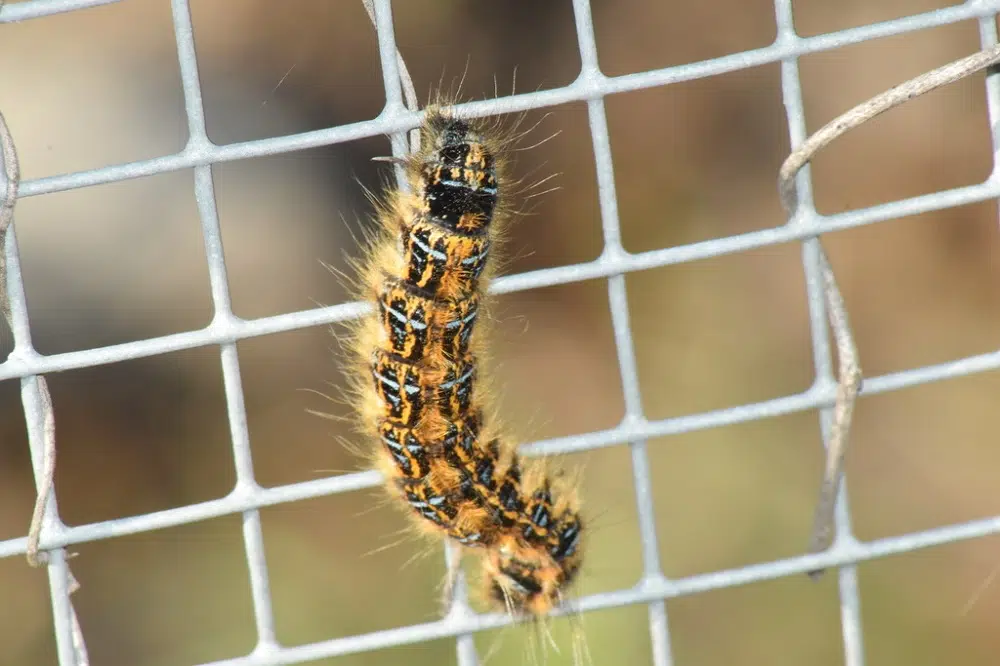
Native to Arizona, the Sonoran Tent caterpillar (Malacosoma tigris) has a changing appearance from one instar to another.
This species is almost completely orange in its first instars, with a hairless body and multiple black bands across the body.
It then starts to darken and appear more black with diminishing orange sections.
Hairs start to appear on the species once it moves past the first instars.
The caterpillar grows white or yellow hair.
Found on multiple types of plants and grasses, this species only bears a few colors into adulthood.
The adult moth is tan, with a few orange hairs in the area of its head.
36. Powdered Dagger Caterpillar
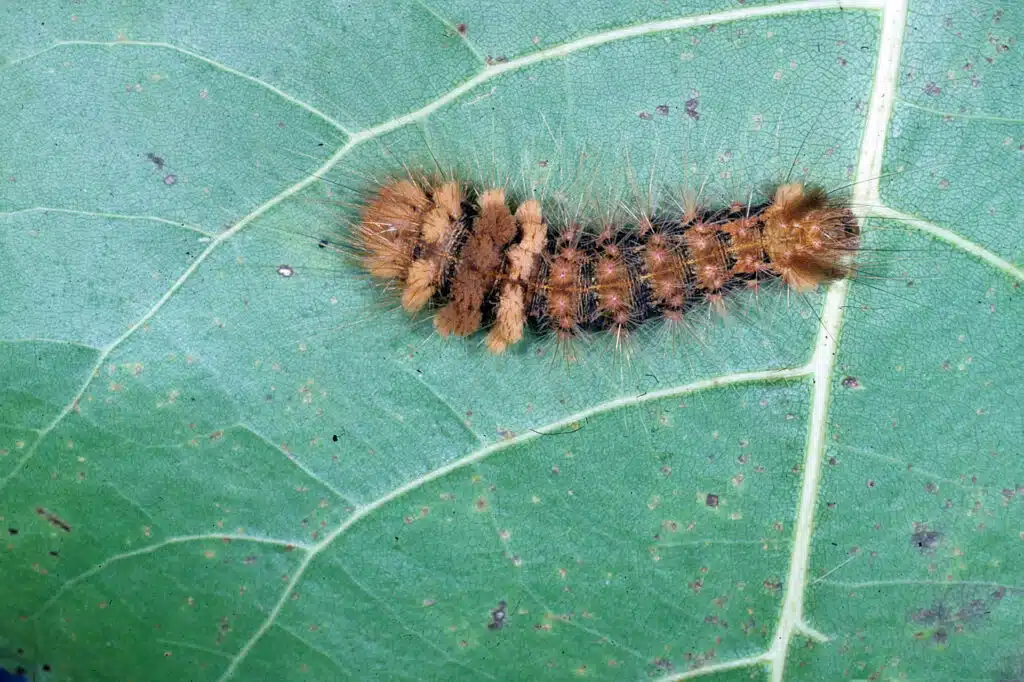
Caterpillars of the Powdered Dagger species (Acronicta impleta) live throughout North America, especially in the East.
Reports have the species present on the West Coast as well, as it’s expanding its habitat.
This species is mostly orange in its first instar.
Just a few black marks are seen across its body at this stage. A combination of bright and dark orange hairs is characteristic of the early instars of the caterpillar.
Its appearance starts to darken as it grows.
The species eventually becomes black with orange sections at the root of the white hairs that cover its body.
White and charcoal tufts are further distinguishable on this caterpillar.
37. Large Gray Dagger Caterpillar
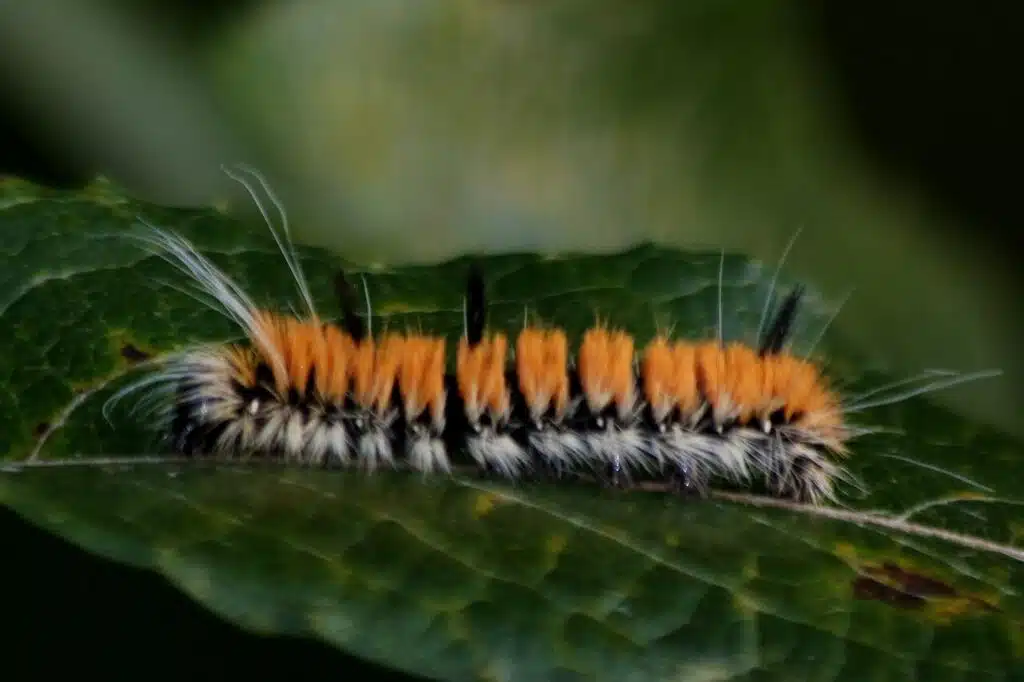
Large Gray Dagger caterpillars (Acronicta insita) are among the species that may cause severe skin rashes in humans.
These caterpillars have hairs connected to toxin glands. Their hairs are hollow and toxins flow from the glands to the tips of the hairs.
Handling these caterpillars isn’t recommended as rashes appear even in mild symptoms.
You can identify the species by its mostly orange and black body.
Orange hairs are seen across the dorsal side of the species with black bands separating these orange areas.
Black and white hairs are seen on the lower sides of the caterpillar.
A few long white hairs are further distinguishable on the body of the late instar caterpillar.
38. Western Sheep Moth Caterpillar
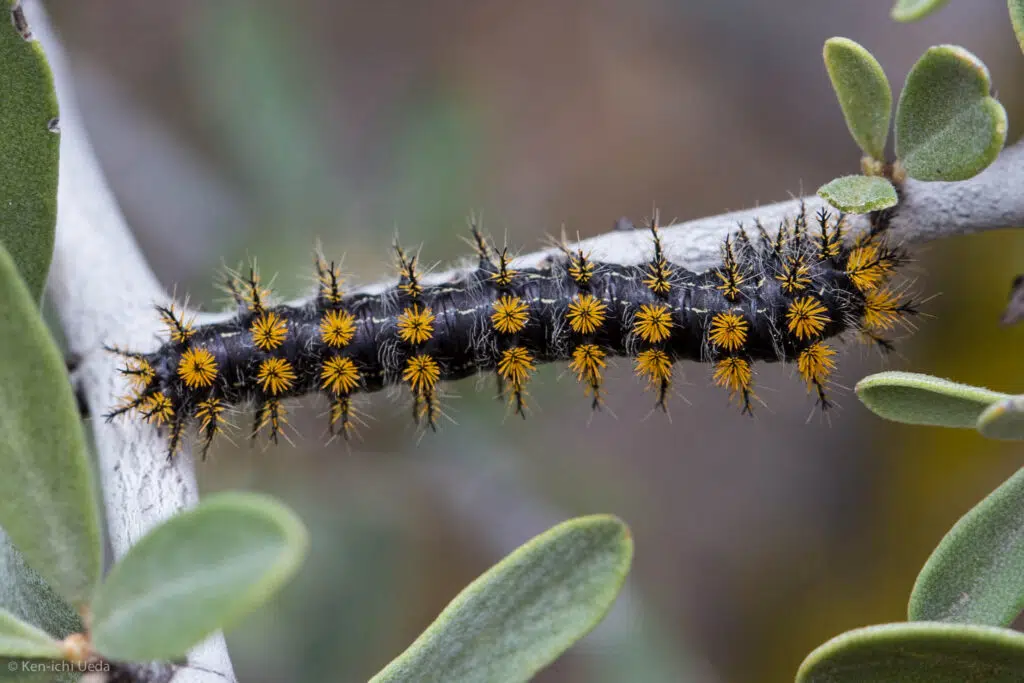
Western Sheep Moth caterpillars (Hemileuca eglanterina) are a species that can live at elevations of up to a few thousand feet.
This species is known for its purple color within its first instars. Orange and black areas are seen across its body.
Orange and black hairs grow longer towards their late instars.
These colors are later seen on the adult purple moth which is also pale yellow or pale orange with black patterns across the wings.
Various plants and trees are hosts for this caterpillar.
Mountain lilacs are among the most common hosts of the species.
Mahogany and wild rose are other common species this tree is typically seen on.
You might also spot Western Sheep Moth caterpillars on willows at low elevations across Western US and Western Canada habitats.